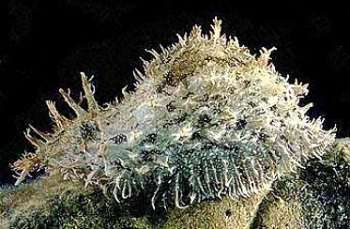
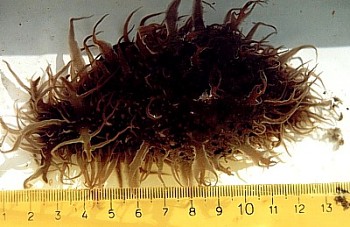
Bursatella leachii
de Blainville, 1817
Order: ANASPIDEA
Family: Aplysiidae
DISTRIBUTION
Found in warm temperate and tropical waters throughout the world. Seven or eight geographical subspecies are recognised by some authorities.
PHOTO
UPPER: B. leachii leachii - Coffs Harbour region, northern New South Wales, Australia. December 1990. PHOTO: Bill Rudman.
LOWER: B. leachii plei - Santa Marta Bay, Colombia, Carribean. PHOTO: Phanor Montoya
The following reference provides an interesting account of the larval biology of Bursatella leachii plei, a subspecies from the west Atlantic. It also has an extensive bibliography on Bursatella research.
Reference:
• Paige, JA. (1988). Biology, metamorphosis and postlarval development of Bursatella leachii plei Rang (Gastropoda: Opisthobranchia). Bulletin of Marine Science, 42(1): 65-75.
Rudman, W.B., 1998 (July 27) Bursatella leachii de Blainville, 1817. [In] Sea Slug Forum. Australian Museum, Sydney. Available from http://www.seaslugforum.net/find/bursleac
Related messages
Bursatella leachii from Thailand
May 20, 2010
From: Nick Chapman
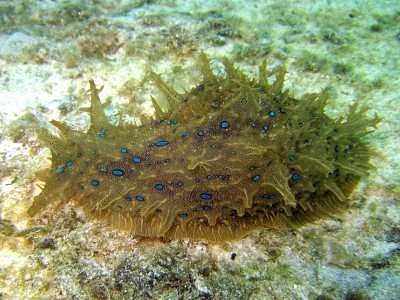
Concerning message #23426:
Dear Bill,
We have had a one day visitation from these handsome (big) beasts. I don't see any records from Thailand.
Locality: Chaloklum Bay, Koh Phangan, 4-5 metres, Suratthani, Thailand, Gulf of Thailand., 14 May 2010, Sandy with algal growth. Length: 15-20 cm. Photographer: Nick Chapman.
Best wishes,
Nick.
info@chaloklum-diving.com
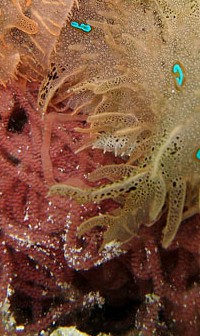
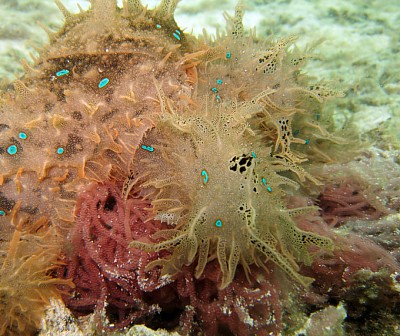
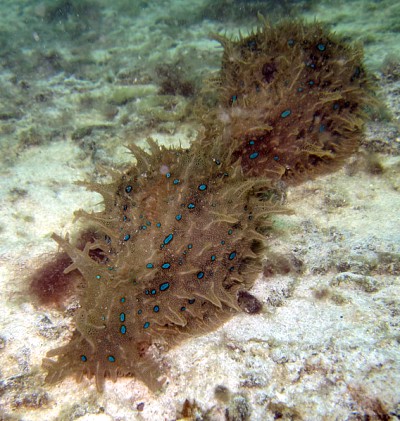
Dear Nick,
From your middle photo showing a large mound of pinkish egg strings [see close-up] I suspect the visitation of these Bursatella leachii that you describe is part of the population's life cycle [see mating chains and mass mortality Fact Sheets]. There seem to be at least 3, possibly 4, animals clustered together. With Sea Hares, a large mass of egg ribbons like this can be produced by multiple animals over a few days.
Best wishes,
Bill Rudman
Bursatella leachii from sthn Queensland
April 29, 2010
From: Deb Aston
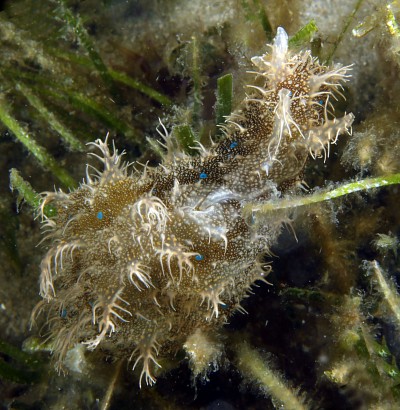
Concerning message #23367:
During a snorkel in seagrass I was surprised to find several amazing critters - Bursatella leachii being one of them.
Locality: Rainbow Channel, Amity, Stradbroke Island, 1.5 m, Qld, Australia, Pacific, 28 March 2010, sea grass. Length: 60 mm. Photographer: Deb Aston.
Deb Aston
dtaston@bigpond.net.au
Aston, D, 2010 (Apr 29) Bursatella leachii from sthn Queensland. [Message in] Sea Slug Forum. Australian Museum, Sydney. Available from http://www.seaslugforum.net/find/23426
Dear Deb,
Yes Bursatella leachi is found in many parts of the world. In the upper photo, the blue spots and white branched papillae on its body make it look very obvious. However your lower photo shows that the when it is deep in the sea grass beds where it is often found the hairy papillae make it very well camouflaged.
Best wishes,
Bill Rudman
Sydney Sea hare ID
April 29, 2010
From: George Evatt
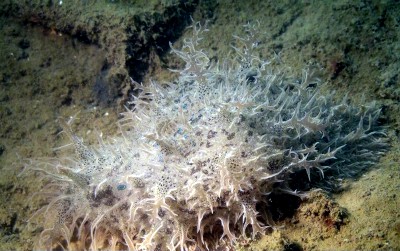
Hi,
I was diving at Cockatoo Island in the upper reaches of Sydney Harbour on the weekend and found this unusual looking sea hare. We were in 3 metres of water and the bottom was very silty. I have checked several books and also the SSF species list Aplysia etc with no sucess.
Locality: Cockatoo Island, Sydney Harbour, 3m, New South Wales, Australia, Upper Sydney Harbour esturie, 25 Aprl 2010, Silty bottom. Length: 8 cm. Photographer: George Evatt.
Any info on which species would be greatly appreciated.
Thanks
George Evatt
Sydney, Australia
george@coralseatv.com
Evatt, G.F., 2010 (Apr 29) Sydney Sea hare ID. [Message in] Sea Slug Forum. Australian Museum, Sydney. Available from http://www.seaslugforum.net/find/23575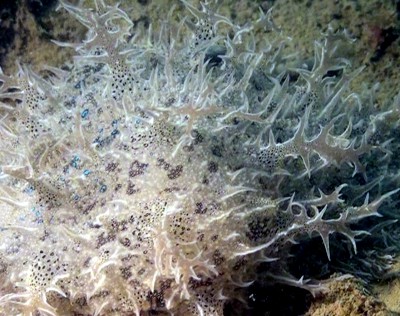
Dear George,
From the branched papillae and blue spots thre is only one species of Sea Hare that this could be - Bursatella leachii. Have a look at the many messages from around the world which are attached to the Fact Sheet for further information
Best wishes,
Bill Rudman
Re: Bursatella leachii in northeastern Spain
March 23, 2010
From: Bella Galil
Concerning message #23207:
Dear Bill and Boris,
Bursatella leachii is a large, not-to-be-missed, easily distinguished, shallow water resident. The first record from the Mediterranean was found in the southern Levantine basin, close to the Suez Canal Mediterranean terminal. Subsequent records place it farther and farther west - the most recent record - from Spain. This pattern of dispersal suits an Erythrean alien. It is unlikely that an entry of such a prominent creature through the Straights of Gibraltar would remain undetected for so long, considering the interest in scuba diving and the many dedicated professional and amateur malacologists in the western end of the sea.
Molecular studies of these lovely creatures would supply us with the evidence we seek.
Bella Galil
bella@ocean.org.il
Galil, B.S., 2010 (Mar 23) Re: Bursatella leachii in northeastern Spain. [Message in] Sea Slug Forum. Australian Museum, Sydney. Available from http://www.seaslugforum.net/find/23367Dear Bella,
I couldn't agree more. Although 'logic' suggests a Red Sea origin we really do need some concrete evidence.
Best wishes,
Bill Rudman
Re: Bursatella leachii in northeastern Spain
March 23, 2010
From: Levent Cavas
Concerning message #23207:
Dear Bill, and Dr Galil,
We had published our observation from Turkey in the Mediterranean Marine Science.
- Kazak, M., Cavas, L., (2007). On the occurrence of Bursatella leachii de Blainville, 1817 in Izmir Bay of Turkey. Mediterranean Marine Science. Vol. 8/2, 87-90.
you can download it from journal web page.
best wishes,
Levent Cavas
Dokuz Eylul University
lcavas@deu.edu.tr
Cavas, L., 2010 (Mar 23) Re: Bursatella leachii in northeastern Spain. [Message in] Sea Slug Forum. Australian Museum, Sydney. Available from http://www.seaslugforum.net/find/23371Thanks Levent,
Best wishes,
Bill Rudman
Re: Bursatella leachii in northeastern Spain
March 19, 2010
From: Boris Weitzmann
Concerning message #23128:
Hello Bill,
I hope these references may be helpful:
- FASULO, G.; PERNA, E. & TOSCANO, F. 1984. Prima segnalazione di Bursatella leachii savygiana Audouin, 1826 per il Golfo di Napoli. Bollettino Malacologico, 20(5-8): 161-163.
- GOFAS, S. & ZENETOS, A. 2003. Exotic molluscs in the Mediterranean basin: current status and perspectives. Oceanogr. Mar. Biol. ann. Rev., 41: 237-277.
- O'DONOGHUE, C. H. & WHITE, K. M. 1940. A collection of marine molluscs, mainly opisthobranchs, from Palestina. Proceed. Malacol. Soc. London, 24: 92-96.
- OLIVER, J. A. & TERRASA, J. 2004. Primera cita de Bursatella leachi (de Blainville, 1817) (Mollusca, Opistobranchia) a Mallorca. Boll. Soc. Hist. Nat. Balears, 47: 37-42.
Boris Weitzmann
Boris@ceab.csic.es
Weitzmann, B., 2010 (Mar 19) Re: Bursatella leachii in northeastern Spain. [Message in] Sea Slug Forum. Australian Museum, Sydney. Available from http://www.seaslugforum.net/find/23177Dear Boris,
Thanks for the references. As I just mentioned to Bella [message #23207] what I was really wondering about was where the Mediterranean population originated, from the Atlantic or from the Red Sea? It would be interesting to know if anyone has any biochemical rather than morphological evidence.
Best wishes,
Bill Rudman
Re: Bursatella leachii in northeastern Spain
March 19, 2010
From: Bella Galil
Concerning message #23128:
As far as I know the first mention of the species in the Med is in the publication cited below
- O'Donoghue CH and White KM (1940) A collection of marine molluscs, mainly opisthobranchs, from Palestina. Proceedings of the Malacological Society of London 24: 92-96.
followed in 1959 by a find off Turkey, by Swennen, 1961
Bella Galil
bella@ocean.org.il
Galil, BS, 2010 (Mar 19) Re: Bursatella leachii in northeastern Spain. [Message in] Sea Slug Forum. Australian Museum, Sydney. Available from http://www.seaslugforum.net/find/23207Thanks Bella,
What I was really wondering about was whether anyone had studied where the Mediterranean population originated, from the Atlantic or from the Red Sea?
Best wishes,
Bill Rudman
Probable Bursatella leachii from Japanese waters
March 19, 2010
From: Hiroyuki Tanaka
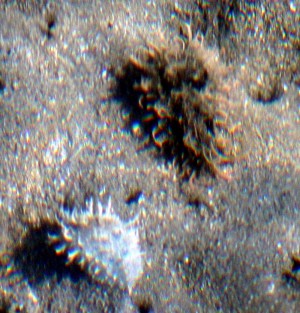
Concerning message #23266:
Hi,
I found so many individuals of probable Bursatella leachii on sand of Miyazaki City, southeastern Kyushu, Japan.
Several subspecies are known among the species, and I want to know which subspecies will be applied to them.
Locality: Sun Marine Miyazaki, near surface, Miyazaki City, Japan, Ocean, Sands, 10 August, 2008, Coastal, sands, yacht harbour. Length: 3-4cm. Photographer: Hiroyuki Tanaka.Thank you.
Hiroyuki
cirrhilabrus@msn.com
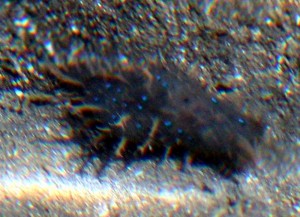
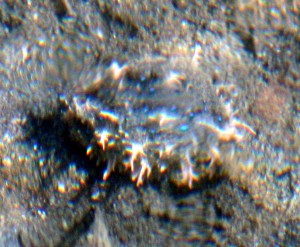
Dear Hiroyuki,
Yes this is Bursatella leachii. I discuss the question of subspecies in this species in an earlier message [#19181] and from that you will see I don't thinks the subspecies make sense. In fact the two animals in your photos have just the sort of differences which have been used to separate subspecies. If you look at the photos in earlier messages on this species you will see that variations in colour and number and size of papillae occur throughout its considerable geographical range. The only character which seems to be linked to a geographic region is the apparent lack of blue-green eyespots in animals from the west Atlantic.
Best wishes,
Bill Rudman
Bursatella leachii in northeastern Spain
January 29, 2010
From: Boris Weitzmann
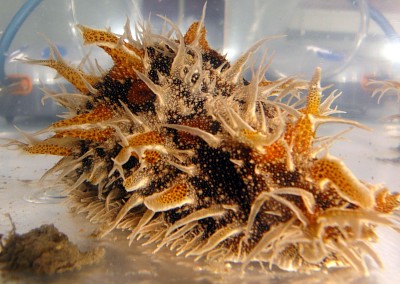
Seven individuals of the species Bursatella leachii up to 12 cm long were observed during october 2007 in the Alfacs Bay (NE SPAIN 40ª 37' 21" N; 0º 36' 31" E) at the Ebro delta. They were moving on a muddy bottom, 2 metres deep, among Caulerpa prolifera and Cymodocea nodosa.
Locality: Alfacs Bay, 2 metres, Spain, Mediterranean Sea, 15 october 2007, Muddy with Caulerpa prolifera. Length: 15 cm. Photographer: B. Weitzmann.
This is first time this species is described at the western end of the Mediterranean sea, and according to its origin (Red Sea) it is the farthest it has expanded across the Mediterranean basin.
The local fishermen affirm that their nets get at times clogged with this animals, which they had never seen before. I wonder if this introduced species will eventually become invasive.
Thank you
Boris Weitzmann
Centre d'Estudis Avançats de Blanes-CSIC.
SPAIN
Boris@ceab.csic.es
Weitzmann, B., 2010 (Jan 29) Bursatella leachii in northeastern Spain. [Message in] Sea Slug Forum. Australian Museum, Sydney. Available from http://www.seaslugforum.net/find/23128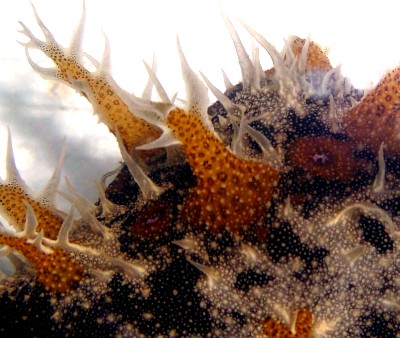
Thanks Boris,
From your description of it clogging fishermen's nets I would say it was already invasive. Has anyone actually demonstrated that it is an invasion from the Red Sea? I can see pinkish eye spots in the close-up alongside which suggests it is not from the Caribbean population which appears to lack eye-spots, but there are populations described from West Africa which I suppose could be the source.
If anyone can give me a reference to any published work on the origin of the Bursatella in the Mediterranean it would be interesting
Best wishes,
Bill Rudman
Re: Bursatella leachii subspecies
August 18, 2009
From: Deng Yan Zhang
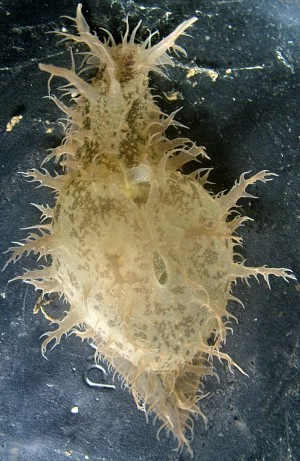
Concerning message #19181:
Dear Bill,
This specimen of Bursatella leachii was recently found at a relatively quiet harbor, is so far I only had saw this species in this area, and was keep at home for three days then let it back to free in water.
The animal has a very soft body, and when holding it in my hand it felt like a jellyfish, apparently full water of water inside its tissues. When first caught it secreted a little purplish ink but later it stopped secreting ink. The animal is opaque white, overlain with numerous purplish-brown dots, which are often accumulated into darker patches on the dorsum.
The length of the animal 110 mm, lives on sand and mud bottom in about 1.2 m.
Locality: St John's, 1.2 m, Antigua, Caribbean sea, 14 June 2009, sand and mud bottom . Length: 110 mm. Photographer: D.Y. Zhang.
Deng Yan Zhang
kejushi@hotmail.com
Zhang D.Y., 2009 (Aug 18) Re: Bursatella leachii subspecies. [Message in] Sea Slug Forum. Australian Museum, Sydney. Available from http://www.seaslugforum.net/find/22564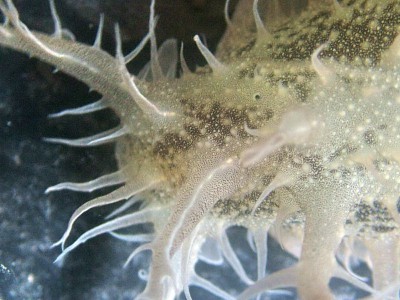
Dear Deane Zhang,
Thanks for these photos of Bursatella leachii from the Caribbean. As I have mentioned before, it seems that Caribbean animals lack the blue or greeen 'eyespots' so characteristic of the species elsewhere in the world.
Sea hares which produce purple ink usually 'run out' of ink after a few squirts. They then have to wait some time to build up a new supply.
Best wishes,
Bill Rudman
Bursatella leachii from New Zealand
March 27, 2009
From: Graham Bould
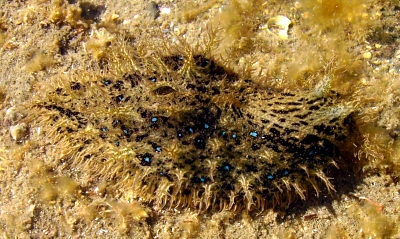
Concerning message #4420:
A number of Bursatella leachii have been found in only one shallow rock pool on the Whangaparaoa Peninsula, near Auckland, New Zealand. They have iridescent blue spots, brighter than other pictures I have seen on the Forum, so I am attaching some photos & hope you can make use of them.
They are extremely well camouflaged against the muddy coraline turf of almost the same colour.
Locality: Rocky shore at low tide, 10 cm, Whangaparaoa, New Zealand, Pacific, 26 March 2009, Intertidal, muddy pool. Length: 50 mm. Photographer: Graham Bould.
Graham Bould
graham@grahambould.net
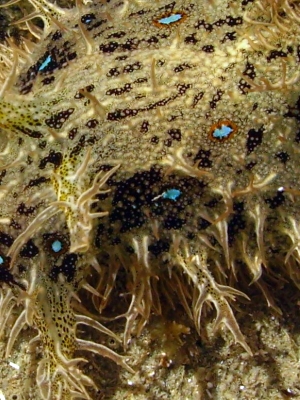
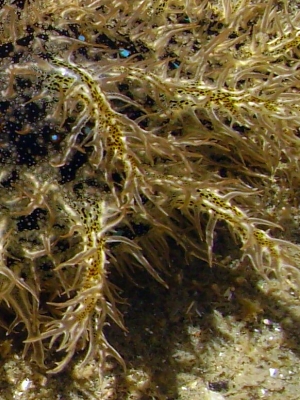
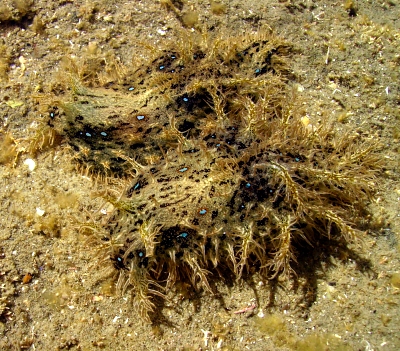
Dear Graham,
Thanks for these photos. The degree of spotting, and the colour of the spots, seems to be quite variable in local populations. It's years since I looked for Bursatella in New Zealand but I can remember the spots being quite green in some animals. Similarly the branched papillae covering the body varies in density and length of the papillae - but this is hard to quantify because the papillae are capable of considerable contraction and expansion. One of the reasons they are so well camouflaged are these branched papillae. One school of thought used to suggest that the papillae acted as secondary gills. While this may be a side effect, I suspect their main function is camouflage, breaking up the edge of the animal so that potential predators don't get a clear picture of an object. This is the reason soldiers often stick bits of vegetation on their helmets, so the smooth edge is broken up.
Best wishes,
Bill Rudman
Re: Bursatella washing ashore East Florida
December 12, 2008
From: Ed Proffitt
Concerning message #21070:
Hi all,
I saw Jon Moore's posting from Nov 2007 and wanted to note that we're seeing the same thing here in Ft. Pierce (about an hour's + drive N of where Jon was) this year last weekend. Fairly impressive numbers although we didn't quantify. Same species of Bursatella in the intertidal areas (mangrove and salt marsh) and shallow subtidal habitats.
Locality: Ft. Pierce, intertidal to 0.2 m, Florida, St. Lucie County, Indian River Lagoon (Atlantic estuary), 09 December 2008, intertidal mangrove, sand mud, shallow subtidal near inlet. Length: approximately 5 - 15 cm
Ed Proffitt
cproffit@fau.edu
C.E. Proffitt, 2008 (Dec 12) Re: Bursatella washing ashore East Florida. [Message in] Sea Slug Forum. Australian Museum, Sydney. Available from http://www.seaslugforum.net/find/22096Thanks Ed,
Bill Rudman
Bursatella leachii & egg masses from Florida
November 21, 2008
From: Anne DuPont
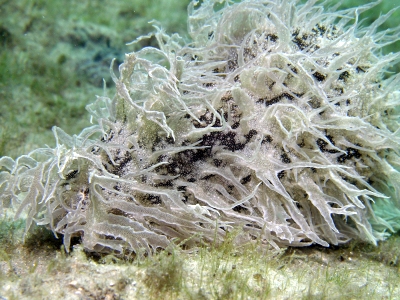
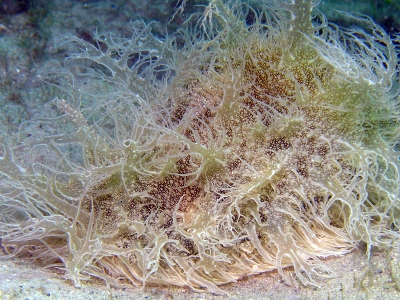
Concerning message #22042:
Hello Bill,
On Sunday we were diving in our local "Lagoon" and we found 7 Bursatella leachii approximately 5 inches long. Four were laying eggs and we saw several other egg masses in the area. We will be diving there tomorrow and try to find and photograph the egg masses again. The animals were quite spectacular in appearance as they were very "hairy."
Locality: Lake Worth Lagoon, Riviera Beach, 15 feet, Florida, USA, Atlantic, November 16, 2008, Lake Worth Lagoon . Length: Appx 5 inches. Photographer: Anne DuPont.
Cordially,
Anne DuPont
Delray Beach, FL, USA
akdupont@bellsouth.net
DuPont, A., 2008 (Nov 21) Bursatella leachii & egg masses from Florida. [Message in] Sea Slug Forum. Australian Museum, Sydney. Available from http://www.seaslugforum.net/find/22071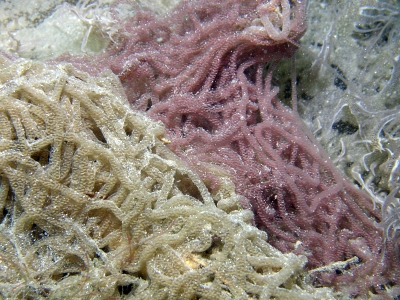
Dear Anne,
After searching through old books to check the spelling of its name [#22070 ], it's a nice co-incidence to receive these nice photos of the spectacular Bursatella leachii.
Best wishes,
Bill Rudman
Re: Bursatella leachii or Bursatella leachi?
November 21, 2008
From: Fabio Crocetta
Concerning message #22066:
Dear Bill,
Thank you for your answer. I found the Cuvier Dictionary and I saw that Cuvier reported that de Blainville described the species as Bursatella leachii in another paper, does anybody have this paper to see the original spelling?
Otherwise if the species was described in the Cuvier dictionary the correct author should be: "de Blainville in Cuvier, 1817" ?
Fabio Crocetta
fabiocrocetta@alice.it
Crocetta, F., 2008 (Nov 21) Re: Bursatella leachii or Bursatella leachi?. [Message in] Sea Slug Forum. Australian Museum, Sydney. Available from http://www.seaslugforum.net/find/22070Dear Fabio,
Many of these early works leave problems for later workers. Authorship and dates of publication were often unclear. In some cases large monographs were published in unnumbered 'parts' over a number of years, as finance became available. Libraries and book buyers bound these parts into single volume when all the parts were received and there is no printed indication when each part was actually published. Discovering when each part was actually published often requires detective work such as looking at date stamps in libraries, checking references to the work in other publications etc..
-
de Blainville, H. M. D., 1817. [In] Cuvier F. (ed.) Dictionnaire des Sciences Naturelles dans lequel on traite méthodiquement des différens êtres de la nature... Levrault & Le Normant: Paris. Vol. 5, Supplement 5: p. 138.
Best wishes,
Bill Rudman
Bursatella leachii or Bursatella leachi?
November 20, 2008
From: Fabio Crocetta
Concerning message #21180:
Dear Bill, I'm writing to you to solve a little problem about the correct use of the adjective "leachi" or "leachii". In CIESM Atlas of exotic species (done by Gofas, Zenetos, Russo & Templado) I found that the right binomial to use is Bursatella leachi http://www.ciesm.org/atlas/Bursatellaleachi.php
as you can see in the not valid synonyms you can find Bursatella leachii.
Also in the Italian check list of the marine fauna (by Prof. Cattaneo-Vietti, 2005-2006) is written Bursatella leachi with only one i
http://www.sibm.it/CHECKLIST/15%20OPISTOBRANCHI/Opistobranchia.pdf
Today (19 November 2008) I found in CLEMAM (by Gofas again) that the correct binomial to use is Bursatella leachii (with two i) and among the synonyms he cited the CIESM Atlas done also by himself
Also on your website I found the use of Bursatella leachii with two i...
Now I have problem to understand which of the two spellings is correct and why?
Can you please help me?
Thank you
Fabio Crocetta
fabiocrocetta@alice.it
Crocetta, F., 2008 (Nov 20) Bursatella leachii or Bursatella leachi?. [Message in] Sea Slug Forum. Australian Museum, Sydney. Available from http://www.seaslugforum.net/find/22066Dear Fabio,
I thought I had answered this before but I can't find a message - so here is a brief answer. Firstly, as I explain in a separate message [#22069], I can't access CIESM Atlas of exotic species without paying - apparently some brilliant bureaucrat has decided to charge all visitors who are not citizens of the countries that fund CIESM. They forget all the websites, such as the Sea Slug Forum, in other parts of the world, that are free to citizens of CIESM funding states.
However that is not your fault! Now to the problem of leachii or leachi. The International Rules recommends that when a new name is being constructed for a person, one i is preferable. However already existing names must be spelt exactly as the original author published them. As Blainville spelt the name B. leachii that is the way we should spell it.
-
de Blainville, H. M., 1817. [In] Cuvier F. (ed.), 1804-1845. Dictionnaire des Sciences Naturelles dans lequel on traite méthodiquement des différens êtres de la nature... Levrault & Le Normant: Paris. Vol. 5: p. 138.
Best wishes,
Bill Rudman
Re: Bursatella leachii from Florida - egg mass
November 18, 2008
From: Robert Bocik
Concerning message #9331:
My Bursatella leachii (Florida sea hare) has laid eggs!!!
How long will they take to hatch? What should be done to care for them if anything? They are in a tank with other fishes should I contain them in a separate tank or block the area from predators?
Thanks this will be great for the kids to see if they survive.
Locality: St Petersburg, 1.5', FL, Gulf flats, Nov 13 2008, Sand/grass. Length: 3.5''
Robert Bocik
rbocik@msn.com
Bocik, R., 2008 (Nov 18) Re: Bursatella leachii from Florida - egg mass. [Message in] Sea Slug Forum. Australian Museum, Sydney. Available from http://www.seaslugforum.net/find/22042Dear Rob,
Have a look at my comments to an earlier message on the same topic [message #18331]. Since this species takes about a week for the larvae to hatch out of the egg ribbon I guess you will see larvae hatching out in the next day or so. There is some evidence that sea hare egg ribbons have some chemical defence but I don't know about the larvae. A greater problem with the larvae is feeding them, as they require live phytoplankton which will be very difficult to provide in a home aquarium. The other difficulty is that most veliger larvae in aquaria tend to get trapped in the surface layer. You may be lucky, but captive breeding of slugs with a free-swimming veliger larvae is quite difficult. There is a paper (Paige, 1986) describing how to culture Bursatella and Aplysia brasiliana in laboratory conditions. Copies of The Veliger should be available in university and museum libraries.
In the species Fact Sheet, I mention another paper by John Paige (1988) on larval development in this species. Here is a brief summary of his findings.
The larvae are planktotrophic, which means they are free-swimming and need to feed on phytoplankton. Growth after hatching is rapid, with veligers reaching full size about 15 days after hatching, and by 19 days they are ready to metamorphose into crawling slugs. To settle out of the plankton and change into crawling slugs they need to find the cyanobacteria [blue-green algae] on which they feed [Lyngbya majuscula ]. Growth after settling is rapid and within 15-20 days the larval shell is discarded and they are beginning to look like adult slugs, and can discharge a small cloud of ink if irritated.
-
Paige, J. A. (1986). The laboratory culture of two Aplysiids, Aplysia brasiliana Rang, 1828, and Bursatella leachii plei (Rang, 1828) (Gastropoda: Opisthobranchia) in artificial seawater. The Veliger 29(1): 64-69.
-
Paige, J. A. (1988). Biology, metamorphosis and postlarval development of Bursatella leachii plei Rang (Gastropoda: Opisthobranchia). Bulletin of Marine Science, 42(1): 65-75.
Best wishes,
Bill Rudman
Bursatella leachii from Mozambique
April 14, 2008
From: Valda Fraser
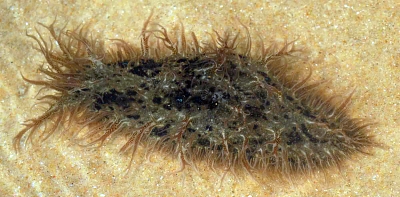
Dear Bill
Can you identify these seahares? They are very social animals. Like to move about "nose-to tail" (Risbecia style) in pairs or large numbers. Also saw numerous heaps of them. Refer to photo. Looks like loads of fun! Sometimes with eggs, sometimes without. Have also attached what I think to be a juvenile ... similar blue spots.
Locality: Pomene, 0 - 1 m, Mozambique, Indian Ocean, 12 February 2008, Tidal pool. Length: 80 mm. Photographer: Valda Fraser.
Help.
Regards
Valda Fraser
valdafraser@mweb.co.za
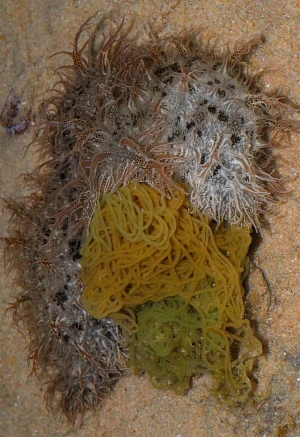
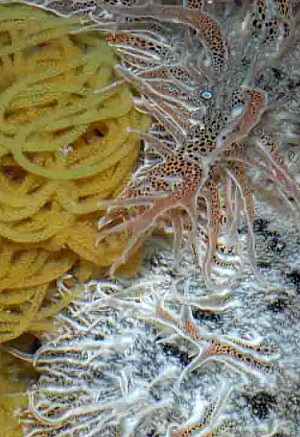
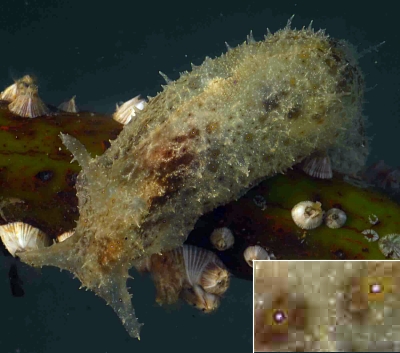
Dear Valda,
These are Bursatella leachii, a very 'hairy' Sea Hare - if you will pardon the pun. They are quite variable in colour and some have more obvious blue 'eye spots' than others. There are other species with similar eyespots, the most common of which is Stylocheilus striatus, which is much smaller in size. Howevere I am pretty sure your 'juvenile' is a juvenile. B. leachii because the parapodial flaps seem to be almost completely fused, which is characteristic of Bursatella, but not of Stylocheilus.
The apparent mating in clusters you have observed, is quite common in sea hares [see Mating Chains] and they have quite powerful chemical attractants ['Love Drugs'] which I discuss in messages attached to the Mating Chains page
Best wishes,
Bill Rudman
Re: Bursatella leachii from Lembeh Straits
March 28, 2008
From: Linda Rutherford
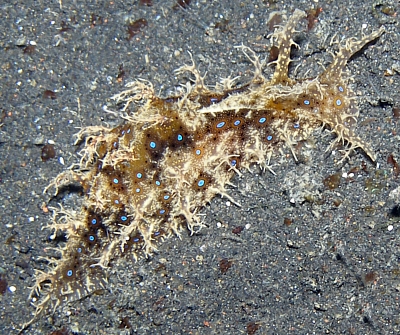
I took this photo in Lembeh Straits [Retaj Clery] during the day at 45 feet, 30 October, 2007, of this solo creature about 5 inches long. I wonder what it is?
Linda Rutherford
Montara, California
lindaruthe@comcast.net
Rutherford, L., 2008 (Mar 28) Re: Bursatella leachii from Lembeh Straits. [Message in] Sea Slug Forum. Australian Museum, Sydney. Available from http://www.seaslugforum.net/find/21479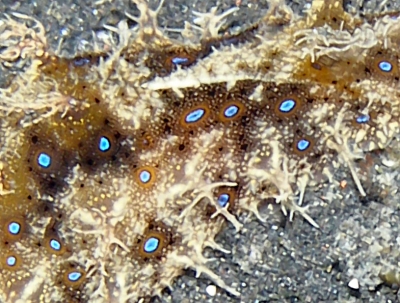
Dear Linda,
This is the sea hare Bursatella leachii. It is interEsting to get a record from Indonesia as we have few records on the Forum of this species from the tropical Indo-West Pacific. The bright blue eyespots on your animal link it to the colour forms found in Singapore and Korea rather than the nthn Australian and SW Pacific animals in which the eyespots are usually not so obvious
Best wishes,
Bill Rudman
Bursatella leachii from Turkey
November 24, 2007
From: M. Kazak & L. Cavas
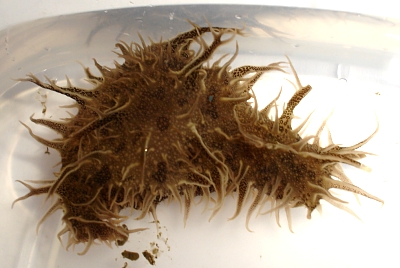
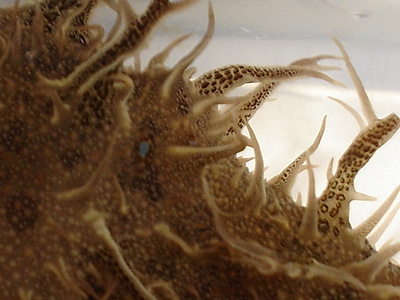
Dear Dr.Rudman,
Ms Melike Kazak, a high school student, informed me that she found a strange animal on the Izmir-Inciralti coastline. When I went to the area with Ms Melike Kazak, I saw lots of the sea hare Bursatella leachii in Gracilaria sp. meadows. We have photographed and examined the species.
Locality: Izmir, 50 cm, Turkey, Mediterranean, 28 October 2007, Muddy . Length: 5-11 cm. Photographer: Melike Kazak - Levent Cavas.
Best regards,
Melike & Levent
Melike Kazak - Takev College - Sahilevleri Izmir, Turkey
Levent Cavas - Dokuz Eylul University, Faculty of Arts and Sciences, Department of Chemistry-Biochemistry, Izmir, Turkey
levent_cavas@yahoo.com
Kazak, M. & Cavas L.,, 2007 (Nov 24) Bursatella leachii from Turkey. [Message in] Sea Slug Forum. Australian Museum, Sydney. Available from http://www.seaslugforum.net/find/21180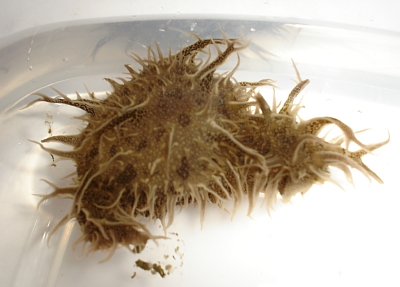
Dear Melike,
Thanks for this record of the species from the Mediterranean. It's valuable to be able to compare the colour and shape of specimens from various parts of the world.
Best wishes,
Bill Rudman
Bursatella washing ashore East Florida
November 13, 2007
From: Jon Moore
Hi Folks,
Just some information for you all.
On 29 Oct 2007, I took my marine bio class to a mangrove site in the Lake Worth Lagoon at MacArthur Beach State Park in North Palm Beach, Florida. As we walked down to the intertidal, we discovered 50+ small sea hares stranded in the intertidal at low tide. We put several into a tank and I determined they were Bursatella leachii. They were still alive, so my class went around for a few moments picking them up and putting them back into the lagoon. We put back at least 50 individuals and there could possibly have been many more among the roots of the red and black mangroves around there.
I just thought you might be interested in the continued washing ashore of this species around Florida.
Locality: North Palm Beach, 0 m, Florida, USA, Atlantic Ocean, 29 October 2007, intertidal mangrove flats. Length: 50-70 mm. Photographer: Jon Moore.
Jon Moore
jmoore@fau.edu
Moore, J., 2007 (Nov 13) Bursatella washing ashore East Florida. [Message in] Sea Slug Forum. Australian Museum, Sydney. Available from http://www.seaslugforum.net/find/21070Thanks Jon,
Bill Rudman
Rudman, W.B., 2007 (Nov 13). Comment on Bursatella washing ashore East Florida by Jon Moore. [Message in] Sea Slug Forum. Australian Museum, Sydney. Available from http://www.seaslugforum.net/find/21070Bursatella leachii at Sanibel Island, Florida
November 12, 2007
From: Camilla Cheatham
I wanted to report my sightings of large "herds" of sea hares or sea slugs seen while snorkeling on Sanibel Island, Florida, at the end of October 2007. Although I have been to Sanibel many times, I have never seen anything like this. They were tan/brown, about 2 - 4 inches long and covered with short hair-like tentacles or appendages. Countless numbers, inching across the sand. After looking at the photos on this site, I would guess they were Bursatella leachii?
Locality: Lighthouse Beach, Sanibel Island, 2 - 3 feet, Florida, United States, Gulf of Mexico, 31 October 2007, Intertidal. Length: ranged 2 - 4 inches
Camilla Cheatham
camilla_cheatham@hotmail.com
Cheatham, C., 2007 (Nov 12) Bursatella leachii at Sanibel Island, Florida. [Message in] Sea Slug Forum. Australian Museum, Sydney. Available from http://www.seaslugforum.net/find/21106Thanks Camilla,
Certainly sounds like Bursatella,
Best wishes,
Bill Rudman
Slug or not?
August 11, 2007
From: Gary Jackson
While at Fort Walton Beach in Florida, we found several "jelly balls" on the beach. We didi not know what they were and my son put one in a bucket with some water. Later he checked it and it had unrolled and looked very much like a slug you see around the house but he was clear. He did have spikes all over his back. When rolled back out onto the shore, it rolled back into a ball and shot out a purple liquid. Is this a sea slug or not? We are just guessing that it is.
Locality: Fort Walton Beach, shore line, Florida, USA, Gulf of Mexico, 29 June 2007, shore surf. Length: 1 inch. Photographer: no photo taken.
Gary Jackson
zot033@aol.com
Jackson, G., 2007 (Aug 11) Slug or not?. [Message in] Sea Slug Forum. Australian Museum, Sydney. Available from http://www.seaslugforum.net/find/20155Dear Gary,
It's most probable that they were Sea Hares. The squirting of purple ink is a pretty good sign. In the last month or so we have received quite a few messages from Florida about large numbers of Bursatella leachii washing up so at a guess I think that is the species you have found.
Best wishes,
Bill Rudman
Sea Slug Mating Season? - Florida
July 19, 2007
From: Lisa Overstreet
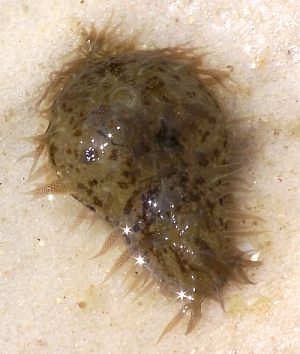
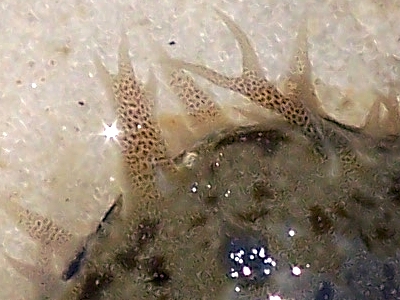
We recently visited Panama City Beach, Florida. On 12 July 2007, we noticed some small dark slimy spots on the beach. Our boys dug a hole and filled it with ocean water and put them in the water and they opened up and started moving around. The picture is of the ones retrieved from the beach. They varied in length from about 5 cm long to 6 cm long and the width was 2 cm to 2.5 cm.
The interesting thing was when it got dark and we returned to the beach to look for small fish and sand crabs to catch in our nets to observe, there were thousands and thousands of these slugs washed up on the beach with the tide. Many were in piles, and we assume it could have been the mating chain spoken of elsewhere in this site. Could you please tell us what type of creature this is, and a little about their life cycle, or what was going on?
Locality: Panama City Beach, Washed up on the beach from the tide, Florida, USA, Gulf of Mexico, 12 July 2007, On the beach, washed in from the tide. Length: 6 cm. Photographer: Lisa Overstreet.
Lisa Overstreet
overglaz@alltel.net
Overstreet, L.M., 2007 (Jul 19) Sea Slug Mating Season? - Florida. [Message in] Sea Slug Forum. Australian Museum, Sydney. Available from http://www.seaslugforum.net/find/20247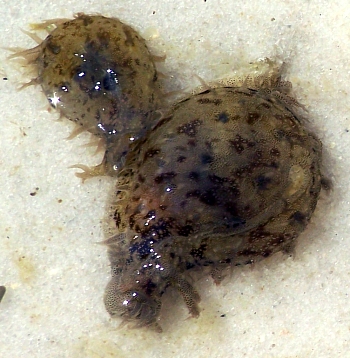
Dear Lisa,
Your animal is Bursatella leachii. It seems to be a good year from Sea Hares in west Florida. I have received quite a few messages in the last week or so about this phenomenon so have a look at my reply to message #20225, and follow the links [underlined words or numbers] to other messages and Fact Sheets I have suggested. You should find plenty of background information.
In my answer to the first message [#20224] I could say it was a sea hare and suggested either a couple of species of Aplysia, or two other sea hares - Stylocheilus striatus and Bursatella leachii. Although Brian Mason [message #20235] suggested I was correct in suggesting Aplysia brasiliana, the only photos I have been sent - yours and Tom Johnson's [message #20220] are of Bursatella leachii, so I suspect all these messages are about this species.
If you look at the Fact Sheet for Bursatella and read the comments in the attached messages you will get a good idea about the species. Also look at the Fact Sheet on mass mortality for some thoughts on why these mass 'swarmings' and deaths occur.
Best wishes,
Bill Rudman
Why so many sea slugs??
July 19, 2007
From: Dew Bakker
I was at a little island off the west coast of Florida yesterday and with the current, I saw several dozen sea slugs go by. They were the dark tan color with faint spots. Just like the pictures show when I googled sea slugs. Now, I've spent many many days out at the beach and little islands in the area over many years, and I've never even seen these little guys! I've heard that they are a sign of good water quality... is this true or is there another reason?
Locality: St Petersburg , Florida, Gulf of Mexico
Dew
roverdew@gmail.com
Bakker, D., 2007 (Jul 19) Why so many sea slugs??. [Message in] Sea Slug Forum. Australian Museum, Sydney. Available from http://www.seaslugforum.net/find/20248[Note added 20 July 2007: This is almost certainly Bursatella leachii. See message #20247]
Dear Dew,
It seems to be a good year from Sea Hares in west Florida. I have received quite a few messages in the last week or so about this phenomenon so have a look at my reply to message #20225, and follow the links [underlined words or numbers] to other messages and Fact Sheets I have suggested. You should find plenty of background information.
Best wishes,
Bill Rudman
Sea slug sighting - Panama City Beach, Florida
July 18, 2007
From: James Ker
I lived at Panama City Beach as a kid and have been coming here periodically for about thirty years. During my most recent visit I noticed sea slugs washing up on the shore by the thousands. I have never seen them before and wonder what is going on. Any ideas?
Locality: Panama City Beach, on the beach/2 to 3 feet, Florida, USA, Gulf of Mexico, 07/15/07, beach, clear water. Length: from 1" to 3.5"
James Ker
jameskero@yahoo.com
Ker, J.A., 2007 (Jul 18) Sea slug sighting - Panama City Beach, Florida. [Message in] Sea Slug Forum. Australian Museum, Sydney. Available from http://www.seaslugforum.net/find/20225[Note added 20 July 2007: This is almost certainly Bursatella leachii. See message #20247]
Dear Jimmy,
The following two messages [#20231, #20235] should answer your question. Follow some of the links and look at earlier messages for more background info. These Sea Hares have certainly made their presence felt in Panama City Beach this year
Best wishes,
Bill Rudman
Re: Sea slugs washed ashore - Florida
July 18, 2007
From: Brian Mason
Concerning message #20224:
I was in Panama City Beach from the 11th until the 15th and each day there were thousands of sea hares on the shore and in the water. Aplysia brasiliana is correct. The seem to have come in with the June grass this year, everywhere you found seaweed near shore, there were thousands of them riding within the mats of vegetation. I have been going to the gulf coast for 25 years, and this is the worst I have ever seen them. The water was a little cooler than usual, and tons of algae in the water, so there must have been some turning of the water offshore that brought the sea hares in.
Locality: Panama City Beach, FL, Gulf of Mexico
Brian
b_cmason@msn.com
Mason, B., 2007 (Jul 18) Re: Sea slugs washed ashore - Florida. [Message in] Sea Slug Forum. Australian Museum, Sydney. Available from http://www.seaslugforum.net/find/20235[Note added 20 July 2007: This is almost certainly Bursatella leachii. See message #20247]
Thanks Brian,
Best wishes,
Bill Rudman
Sea Hares at Panama City Beach, Florida
July 17, 2007
From: Theresia Schwinghammer
I found the messages concerning sea hares, from Cheryl Bodden [#20224] and Tom Johnson [#20220 ], very interesting. I was at Panama City Beach this past week and on Friday, 13 July 2007, I also witnessed many of the sea hares washing up. I picked up a few and put them in a bucket of sea water and watched them move around on the inside of the bucket. They were beautiful & I was truly amazed!
Locality: Panama City, Florida USA, Gulf of Mexico, 13 July 2007, Washed up on beach. Length: 2-4 inches
Thanks for the posting & in helping to identify them!
Theresia Schwinghammer
tatms@psci.net
Schwinghammer, T.M., 2007 (Jul 17) Sea Hares at Panama City Beach, Florida. [Message in] Sea Slug Forum. Australian Museum, Sydney. Available from http://www.seaslugforum.net/find/20231[Note added 20 July 2007: This is almost certainly Bursatella leachii. See message #20247]
Dear Theresia,
Glad to be able to help
Best wishes,
Bill Rudman
Sea slugs washed ashore - Florida
July 16, 2007
From: Cheryl Bodden
My family and I just returned from the beaches in NW Florida, specifically, Seagrove Beach. We stayed at the beach for one week and never saw a single sea slug. And then one day, there were thousands of them washed up on the shore. They were still alive and moving and by the time the tide came in and went back out, they were gone. At first we thought they were clumps of mud on the white sand but then we noticed "purple -ooze" coming from the ones that had been stepped on. My children ages 9 and 11 were fascinated by them and I told them that when we returned home, we could search the internet for some answers on what we had witnessed. There were no storms and we want to know why they washed up for one day.
Locality: Beach, on the shore, Florida, USA, Gulf of Mexico, July 19, 2007, Gulf Coast Beach. Length: 1 inch
Cheryl Bodden
Halynn@aol.com
Bodden, C.L., 2007 (Jul 16) Sea slugs washed ashore - Florida. [Message in] Sea Slug Forum. Australian Museum, Sydney. Available from http://www.seaslugforum.net/find/20224[Note added 20 July 2007: This is almost certainly Bursatella leachii. See message #20247]
Dear Cheryl,
From your mention of a 'purple ooze' your animals were definitely sea hares, many species of which can produce this purple or reddish ink. The two species which are often reported washing up in Florida like this are Aplysia brasiliana and A. morio. Have a look at the page on Mass mortality for some discussion on why they wash up in numbers like this. I am not sure why your animals were there for only one day, perhaps the next tide washed them back out again.
The only doubt I have about my identification is that you say they were about an inch [2.5 cm] long, which is a bit small for adult sea hares. It is possible you found Stylocheilus striatus which is a smaller sea hare also found in the Caribbean [see message 19488 ]. Another possibility is that it is Bursatella leachii which Tom Johnson is inquiring about from Florida in another message posted today [#20220 ]
Have a look at earlier messages attached to any of the Fact Sheets I have linked to, they all have interesting information and photos.
Best wishes,
Bill Rudman
What type is this?
July 16, 2007
From: Tom Johnson
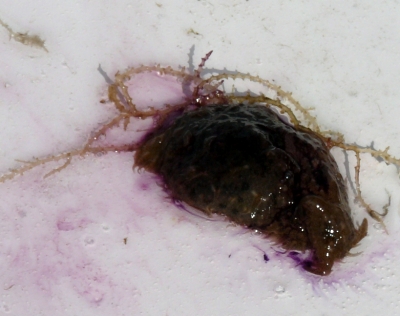
Using a baitcasting net in Charlotte Harbor, SW Florida Gulf Coast, we came up with literally hundreds of these sea slugs or whatever they are. Can you identify them?
Locality: Port Charlotte, 3 - 5 feet, Florida, USA, Gulf of Nexico, 13 July 2007, Clear salt water, weedy, near sandbar . Length: 2-3 inches. Photographer: Tom Johnson.
Tom Johnson
trjmcp@aol.com
Johnson, T., 2007 (Jul 16) What type is this?. [Message in] Sea Slug Forum. Australian Museum, Sydney. Available from http://www.seaslugforum.net/find/20220Dear Tom,
Your animal is Bursatella leachii, one of a number of sea hares found along the Florida coast. Have a look at the Fact Sheets I have linked to and attached messages for more information. Many sea hares can occur in large numbers like this at certain times of their life cycle [see mass mortality Fact Sheet]. The purple ink exuding from the animal is a sure sign that this is a sea hare.
Best wishes,
Bill Rudman
Bursatella leachii
June 28, 2007
From: Doug Clark
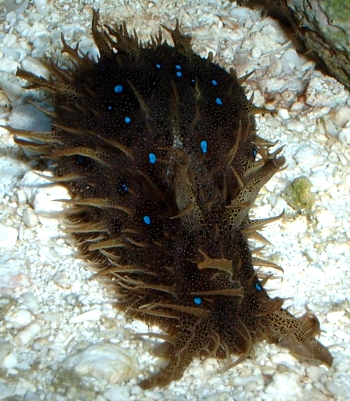
Hello Bill
I recently purchased a Sea hare from a local (Nebraska) fish store. I was advised it was a Blue spotted Sea Hare, however, I have not been able to find any information on this. I thought, at first, it was a Stylocheilus striatus but it does not appear to have the lateral lines. Can anyone identify this?
It's about 1.5 inches but I have no idea where it came from. Photographer: Doug Clark.
Doug
sniper2263@cox.net
Clark, D., 2007 (Jun 28) Bursatella leachii. [Message in] Sea Slug Forum. Australian Museum, Sydney. Available from http://www.seaslugforum.net/find/19545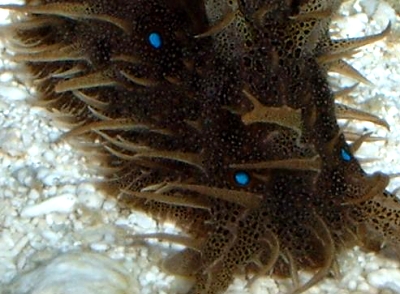
Dear Doug,
This is Bursatella leachii, which is a type of sea hare. I wouldn't normally post this photo, because we have no information about where it came from, but it is an unusual colour form. You'll find plenty about this species on the Forum
Best wishes,
Bill Rudman
Fremantle, Western Australia - many new sightings
May 8, 2007
From: Brent Murdoch
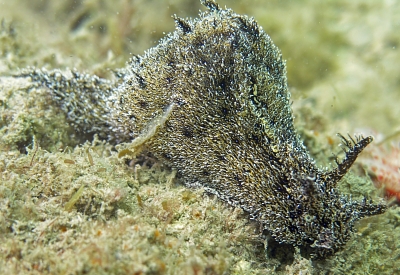
In "Sea Slugs of Western Australia" Wells & Bryce state that Bursatella leachii [page 47 Plate 44] has only been recorded from the Kimberley and Albany in Western Australia. I seen or heard of around 100 today around the South Mole of Fremantle. In the same location I also saw Chromodoris collingwoodi [page 118 Plate 145], also not recorded here before
Not sure if there is anyone who would like to come for a trip to have a look?
On the same dive I saw some other slugs the book says are rare, the dive was just over 2 hours in 3-4 m of water. All 14 slugs listed below were photographed
• Philinopsis (said to be Uncommon) pg 31 Plate 19
• Aplysia cf. extraordinaria (Common) pg 46 Plate 43
• Bursatella leachii (Rare) pg 47 Plate 44
• Elysia ornata (Rare) pg 63 Plate 65, much greener than the plate
• Aphelodoris (Common) pg 96 Plate 111, never recorded here before
• Hypselodris infucata (Common) pg 115 Plate 139
• Dendrodoris carneola (Common) pg 140 Plate 181, never recorded here before
• Chromodoris tinctoria (Uncommon) pg118 Plate 146, I see these every dive here
• Chromodoris collingwoodi (Rare) pg118 Plate 145
• Mexichromis macropus (Uncommon) pg128 Plate 161
• Ceratosoma brevicaudatum (Abundant) pg130 Plate 164
• Dendrodoris tuberculosa (Uncommon) pg 142 Plate 186, not an exact match
• Austraeolis ornata (Uncommon) pg158 Plate 206
Locality: Fremantle, 4m, WA Australia, Indian, 07 January 2007, grass bottom. Length: 100mm. Photographer: Brent Murdoch.
Please drop me a line if anyone wants any photos or is interested in a dive (a short drive close to Fremantle)
Regards
Brent Murdoch
brent@murdoch.ed.au
Murdoch, B.D., 2007 (May 8) Fremantle, Western Australia - many new sightings. [Message in] Sea Slug Forum. Australian Museum, Sydney. Available from http://www.seaslugforum.net/find/19160Thanks Brent,
Books like Fred & Bryce's are only as good as the available information, so its always good to get more records.
Best wishes,
Bill Rudman
Bursatella leachii from Florida
April 3, 2007
From: Mark Javer
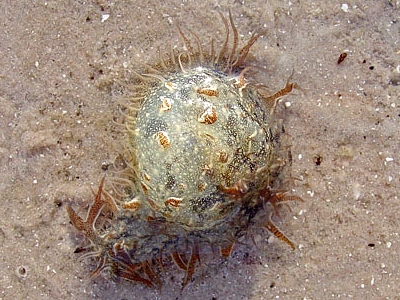
Would really appreciate your help. I've been trying to ID this "thing" for a while now. Photographed it on the beach in Florida.
Locality: beach in Florida, FL, Gulf Of Mexico beach, wet sand. Photographer: Mark Javer.
Thank you,
Mark
brightsidestudio@gmail.com
Javer, M., 2007 (Apr 3) Bursatella leachii from Florida. [Message in] Sea Slug Forum. Australian Museum, Sydney. Available from http://www.seaslugforum.net/find/19797Dear Mark,
Sea Slugs don't look their best when they are half out of water, especially when they have long tapering papillae covering their body. This is the sea hare Bursatella leachii. Have a look at the species Fact Sheet, and associated messages, for more information
Best wishes,
Bill Rudman
Bursatella in aquarium
March 28, 2007
From: Lori Blair
I bought this sea hare yesterday from the lfs and I don't know what type it is. it's big, about 2 1/2 inches. brown, with looks like branches sticking off of it and it also has tiny blue spots on it. can you give me some info. on this species please. What it eats, if it dies, is it toxic to my fish.
Thanks,
Lori
Ontario, Canada.
loriblair60@yahoo.ca
Blair, L., 2007 (Mar 28) Bursatella in aquarium. [Message in] Sea Slug Forum. Australian Museum, Sydney. Available from http://www.seaslugforum.net/find/19758Dear Lori,
There should be a law against aquarium shops selling living things they have no idea how to care for. I suspect your animal is Bursatella leachii. This animal normally lives on an organic layer found growng over the sandy bottom, so it will probably find things to eat in your aquarium - even help to keep the glass clean. At 2 1/2 inches long, your animal is reaching maturity and may only have 2 or 3 months left to live as their life cycle is usually less than a year. Will it be toxic to your fish if it dies? Sea hares have acid glands in their skin so I doubt if the fish will try nibbling it while it is alive. If it dies, then like all rotting material it will foul the water, but no more than a dead fish or a soft coral would.
Best wishes,
Bill Rudman
Bursatella leachii from Tampa, Florida
March 7, 2007
From: Angie Kuzminski
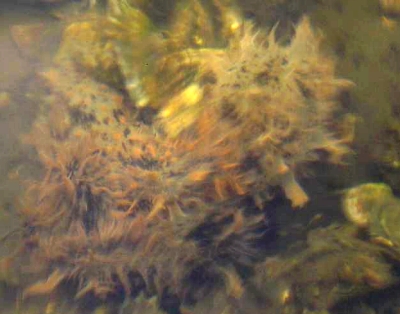
Can these creatures be identified? They looked like slow-moving, hairy sea slugs...? The attached picture shows 2 of them close together, photographed through about 1 foot of water at low tide.
Locality: Residential Docks in Palmetto, 1-3 feet (present at low and high tide), Florida (Tampa Area), USA, Gulf of Mexico, 24 February 2007, Residential docks (rocky). Length: 6-7 inches. Photographer: Angie.
Angie Kuzminski
angie.kuzminski@gmail.com
Kuzminski, A., 2007 (Mar 7) Bursatella leachii from Tampa, Florida. [Message in] Sea Slug Forum. Australian Museum, Sydney. Available from http://www.seaslugforum.net/find/19607Dear Angie,
Although they are hard to see in your photo, this is exactly what Bursatella leachii looks like through a foot of water. They are indeed 'hairy sea slugs'. Have a look at the Fact Sheet, and earlier messages on this species, for more information
Best wishes,
Bill Rudman
Bursatella leachii in Malaysian shrimp ponds
February 28, 2007
From: Huan Ung
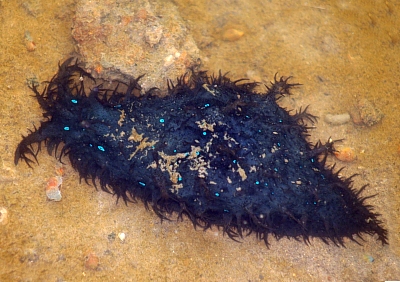
This is indeed a wonderful website and I wonder if the Australian Museum has begun Bar-Coding the various species using the Cytochrome Oxidase 1 gene that is currently being used to barcode all kinds of organisms. It will also be interesting to see how much the DNA sequence varies for the various geographical types of species that are cosmopolitan such as Bursatella leachii as their polymorphic forms are diverse. Anyway, we have 500 aquaculture ponds for shrimp and one just got colonized by thousands of Bursatella leachii. Strangely the postlarval shrimps have disappeared (died?) and I'm wondering if the pink dye is toxic or not? Also, if there is any commercial use of these animals, I may decide to preserve this pond as a closed system breeding population of this (invasive) species. Is it true that Chinese actually eat this animal? or make natural medicines from it?
Locality: Umas Umas River area, 0.2-1.4 metres, Sabah, Malaysian Borneo, 24 February 2007, within newly stocked shrimp pond. Length: 60-110mm. Photographer: Ms.Claire Emmanuelle Bue.
Huan Ung
huanung@yahoo.com
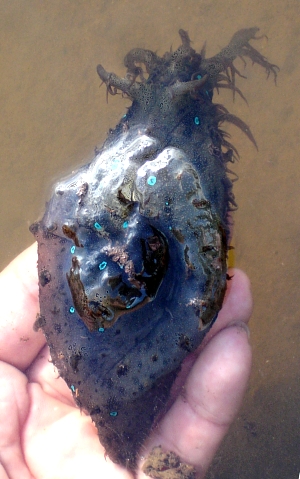
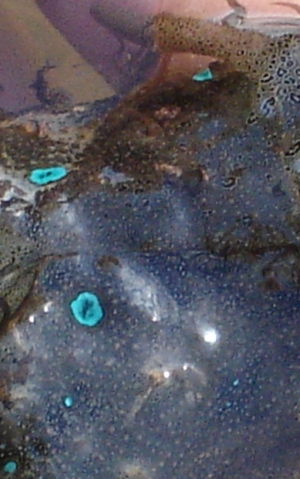
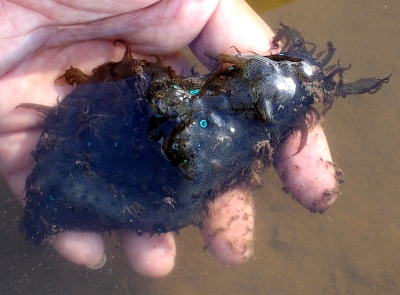
Dear Huan,
There is still considerable debate on the efficacy of bar-coding amongst taxonomists. Also with such limited funds availble for basic research I would rather encourage students to study the basic biology of some of these common, abundant animals than to study slight differences in their cytochrome oxidase genes. We could then be able to answer questions like yours.
As you will see from earlier messages on this species, they do at times appear to 'take over' shrimp/prawn ponds. I assume this is partly because they feed on the blue-green algal layer [cyanobacteria] often found growing over the substrate. However as Doug Pearson [messages #363; #359]and Tom Capo [#368] suggest, larval Bursatella in the shrimp/prawn ponds could affect the phytoplankton bloom in the ponds and so effect the larval prawn food supply.
Concerning the use of Bursatella as food or medicine in China. I can find no good evidence of any sea hare being used as food, but there are places [Fiji, Philippines] where their eggs are eaten. I have no information on whether they are used for traditional medicine. Many other marine animals have been called sea slugs [see sea cucumbers] so the literature is quite confusing.
Concerning their pink/purple ink. Have a look at the Fact Sheet on the topic. There is no real evidence to suggest it is toxic in normal concentrations.
Best wishes,
Bill Rudman
Bursatella leachii from the Gulf coast of Florida
January 24, 2007
From: Sonnia Smith
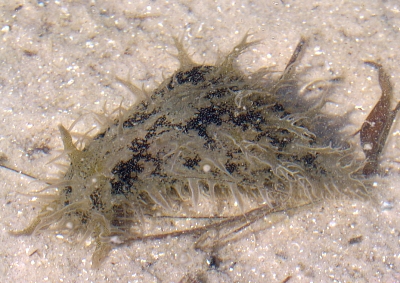
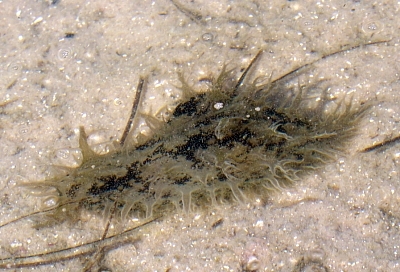
Good afternoon! First off, I wanted to thank you for a wonderful site. It has provided me with endless amounts of fun poking about and learning about sea slugs.
On a walk along the beaches of Honeymoon Island, Florida, I found about 40 slugs crawling along the bottom of a shallow pool of water. The tide was out, and the pool appears to be a typical depression found along the shoreline here, no more than 8 inches in depth, with a sandy bottom and surrounded by grasses and similar vegetation. I found a post with photos that almost match what I saw, identified as Bursatella leachii.
The slugs were roughly 4 inches in length. Though you cannot see it clearly in the photos, the edges of the "frills" on the slug were a vibrant, almost glowing light blue-green. I have never to my recollection seen this slug in the waters in this area, though I have seen other slugs in the past.
The precise location of Honeymoon Island, which is about 20 miles north of Tampa Bay, Florida, along the Gulf of Mexico, roughly half way up the state's western coast.
Locality: Honeymoon Island, Florida , 8 inches, Florida, USA, Gulf of Mexico, 20 January 2007, Intertidal, marshy. Length: 4 inches. Photographer: Sonnia Smith.
Again, thank you for the site, and thank you for the opportunity to send you a hello from Florida!
Sonnia Smith
sonnia.smith@gmail.com
Smith, S., 2007 (Jan 24) Bursatella leachii from the Gulf coast of Florida. [Message in] Sea Slug Forum. Australian Museum, Sydney. Available from http://www.seaslugforum.net/find/19308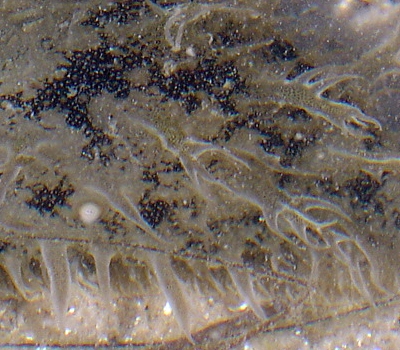
Dear Sonnia,
Thanks for the report. Yes this is B. leachii. You can see from the close-up why it is sometimes called the 'ragged sea hare'. One other thing which interests me in the close-up is that this animal doesn't have any blue 'eye spots' in dark brown-black patches on the skin. In a recent message [#19181] about subspecies of B. leachii, I said that the only thing I could find separating the Caribbean form of this species from those in other parts of the world was its absence of blue spots. It's very hard to prove an absence is real, but its nice to have another photo showing this absence.
Best wishes,
Bill Rudman
Bursatella leachii from New South Wales
January 16, 2007
From: Keith Suddaby
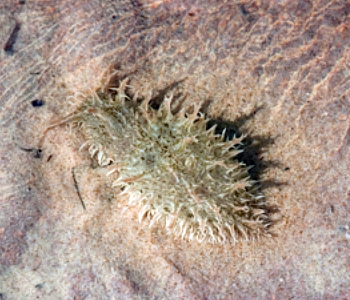
Thank you very much.
I hope the image is OK for identification?
kandm.10suddaby@virgin.net
Suddaby, K.M., 2007 (Jan 16) Bursatella leachii from New South Wales. [Message in] Sea Slug Forum. Australian Museum, Sydney. Available from http://www.seaslugforum.net/find/19215Dear Keith,
This is not a Sea Cucumber but a Sea Hare. The species is Bursatella leachii, which, as you will see from the Fact Sheet and associated messages, has a worldwide distribution. Good luck with your photo competition
Best wishes,
Bill Rudman
Bursatella leachii subspecies
January 12, 2007
From: Augusto Medeiros
Good morning,
I´m working on Bursatella leachii and, as you said, some authors have divided the world population of it into geographic subspecies. I´d like to know if there are papers that make the comparison between them and if you could tell me the name of all known B. leachii subspecies.
Thank you very much for your help
Augusto
augumed@gmail.com
Medeiros, A., 2007 (Jan 12) Bursatella leachii subspecies. [Message in] Sea Slug Forum. Australian Museum, Sydney. Available from http://www.seaslugforum.net/find/19181Dear Augusto,
I would be interested to know what research you are doing and where. Concerning the subspecies of B. leachii, Eales & Engel (1925) reviewed Bursatella worldwide and concluded there was only one species. They thought it would be convenient to recognise six subspecies but could give no clear definitions of each subspecies except to suggest geographic regions.
Bebbington (1969) proposed another subspecies for populations from Ghana and Nigeria, although there was already the 'subspecies', B. leachii rosea from West Africa. Bebbington also noted that Eales and Engel 'found it was not possible to give exact distinguishing characters for [each] subspecies, but noted that B. leachi leachi always had green ocelli while B. leachi africana is very woolly in appearance.'
It seems to me that the most woolly thing is the argument in support of the subspecies. Bebbington argued that his B. leachii guineensis was less woolly than the South African B. leachii africana, and that its dark colour differentiated it from the other west African subspecies, B. leachii rosea which is pinkish in colour. He also consider his new subspecies differed from the Pacific B. leachii leachii in having peacock blue eye spots rather than green.
From my observations and published accounts, the colour of eye spots can vary within a local population, as can the background colour and the degree of 'woolliness'. From my reading of the literature the only difference I can find is that the Caribbean form seems to lack the blue/green eyespots found in animals everywhere else in the world. If someone could confirm that it would be interesting. Other than that, I know of no consistent differences. Interestingly, Stylocheilus striatus, another widespread sea hare shows similar variability in background colour, 'woolliness' and colour of eyespots. I have been reluctant to list the 'subspecies' because I don't wish to encourage people who seem obsessed with publishing such lists. But in the interests of the free exchange of information here they are - but I don't support their use.
Bursatella leachii leachii de Blainville - Indo West Pacific
Bursatella leachii savigniana Audouin - Red Sea
Bursatella leachii africana (Engel) - South Africa
Bursatella leachii rosea (Engel) - West Africa
Bursatella leachii guineensis Bebbington - West Africa
Bursatella leachii pleii (Rang) - Caribbean region
Bursatella leachii lacinulata Gould - Brazil
-
Bebbington, A. (1969) Bursatella leachi guineensis subsp. nov. (Gastropoda, Opisthobranchia) from Ghana. Proceedings of the Malacological Society of London, 38: 323-341.
-
Eales, N.B. & Engel, H. (1935) The genus Bursatella de Blainville. Proceedings of the Malacological Society, 21: 279-303.
Best wishes,
Bill Rudman
Re: Opisthobranch ova & capsules
November 16, 2006
From: Tony Fernando
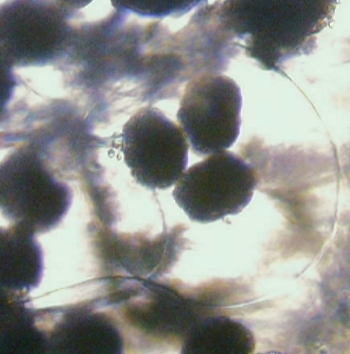
Concerning message #3132:
Hello,
I saw the post with regard to multiple developing larvae inside egg capsules. I've been trying to culture Bursatella leachii plei through settlement with no success since August, but I can say that that species does also have multiple developing larvae in each egg capsule (I've seen 5-6). Attached are two photos; the upper one from the day an egg mass was laid, and the lower one taken on the third day after the egg mass was laid. I also have video of the pre-veligers(?) bouncing off each other as they move around inside their capsule. Both photographs were taken by me with an Olympus Mic-D in transmitted light mode at 255x. B. leachii normally hatches after 6 days when kept at room temperature.
Tony Fernando
Student, Applied Marine Science Department
Carteret Community College
Morehead City, NC (USA)
anthonyfernando@yahoo.com
Fernando, A.V., 2006 (Nov 16) Re: Opisthobranch ova & capsules. [Message in] Sea Slug Forum. Australian Museum, Sydney. Available from http://www.seaslugforum.net/find/18331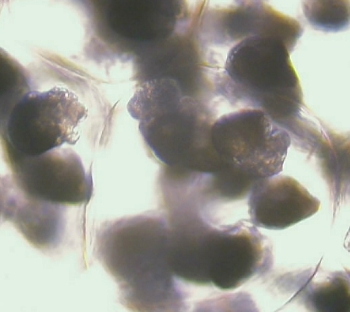
Dear Tony,
Thanks for the information in the eggs. As you have found it is difficult to get the conditions right for keeping planktonic larvaealive and healthy in artificial conditions. Not only do you need to find the right planktonic algae for them to feed on but you have to find some way of keeping the veliger larvae away from bacteria and protozoa which will kill them.
Amongst the sea hares there is quite a variation in the number of eggs which will be found in each capsule. Some such as Aplysia fasciata can have over 40 embryos per capsule, while others such as A. punctata, have relatively few (approx 4 per capsule).
Best wishes,
Bill Rudman
Ragged Sea Hares on the beach
August 28, 2006
From: Cathy Zollo
I am a reporter for the Sarasota (Florida, USA) paper, and I did a story the other day about hundreds of ragged sea hares [Bursatella leachii] coming up on the beach and spewing this purple ink.
Locality: Anna Maria Island, about 15 miles south of St. Petersburg, Florida, Florida, USA, Gulf of Mexico, 22 August 2006, sandy beach. Length: small cucumber
Locals say they've never seen them do this (come up on the beach or spew the ink), but it's important to note that we have a moderate to severe red tide bloom offshore as well as a Trichodesmium bloom. Scientists here say they aren't sure about this, but they think the critters were trying to get away from the red tide. I've seen on the Web where other sea slug species intentionally come up on the beach, so it's a bit confusing.
I would appreciate any thoughts, suggestions or information (or pointing elsewhere for the answer) about what might have been going on so I can share this with my readers. I would, of course, give you guys credit for the info.
Thanks,
Cathy Zollo
cathy.zollo@heraldtribune.com
Zollo, C., 2006 (Aug 28) Ragged Sea Hares on the beach. [Message in] Sea Slug Forum. Australian Museum, Sydney. Available from http://www.seaslugforum.net/find/17627Dear Cathy,
Bursatella leachii [Ragged sea hare] is found worldwide and it is certainly one species which at times is found washed ashore like this in large numbers. If you go to the General Topics List [in Menu at top left of page] you will find a whole section on Sea Hares. I would suggest you have a look at the Mass Mortality page which has background information on this phenomenon and links to many examples which have been reported on the Forum. You will see there that there does seem to be a simple cause and effect answer to these strandings, other than that a whole generation has probably reached old age and any adverse happening may tip the balance towards death.
Have a look at the page on their purple ink - although it reminds us of squid ink, it does not seem to have any defensive function and may just be a rather spectacular waste product.
Hope you find enough information for your readers. We have quite a few messages from the good people of Florida reporting swarming and swimming in two of your local sea hares, Aplysia brasiliana and A. morio.
Best wishes,
Bill Rudman
Bursatella leachii from Guajira, Colombia
March 13, 2006
From: Adriana Aguirre
Hi, my name is Adriana Aguirre, I'm a former biology student actually performing my thesis dissertation in the macrofauna of sea grass meadows (Thalassia testudinum) of La Guajira, Colombia. In one of my surveys lots of Bursatella leachii (aprox 167 ind. in a 60 m2 transect) were found, and after asking Nestor Ardila we concluded it could be a reproductive conduct due to the linear disposition in which they occurred. In this respect, I contact you for any reliable information of this species you could please give me to support this conclusion.
Locality: Musiche, 4,6 m, Guajira, Colombia, Caribbean sea, 14 August 2005, Sea grass meadows (Thalassia testudinum ). Length: 6 cm
Thanks for your valuable help and attention.
Adriana Aguirre
adriana_aguirre@invemar.org.co
Aguirre, A.A, 2006 (Mar 13) Bursatella leachii from Guajira, Colombia. [Message in] Sea Slug Forum. Australian Museum, Sydney. Available from http://www.seaslugforum.net/find/16078Dear Adriana,
It's a bit hard to know what was happening. As you will see on the pages on mention below Sea Hares are often found in large congregations but we are not sure why they form large dense groupings like this. But like most opisthobranchs, when they find themselves in high densities, a lot of mating takes place. It is not logical though to say that since much mating takes place at high densities, that is the reason they are in such high densities.
Have a look at message #3919 for some background information on Bursatella behaviour. Also have a look the Fact Sheets on Mass Mortality and Population Fluctuations.
Best wishes,
Bill Rudman
Bursatella leachii from Queensland
March 7, 2006
From: Alison Miller
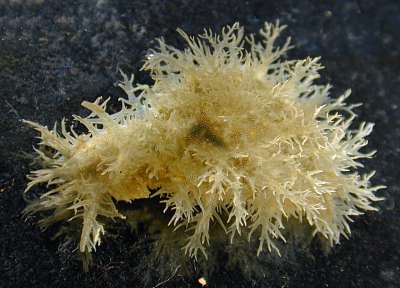
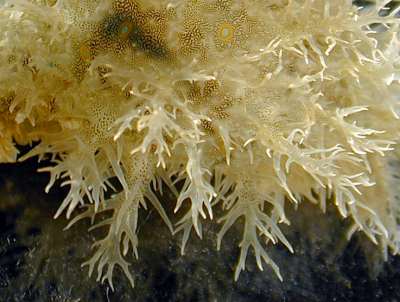
Hi Bill,
Ian Loch found this at Magnetic Is. We're thinking Stylocheilus or possibly Bursatella. No obvious 'stripes'...
Locality: Magnetic Is, Intertidal, Queensland, Australia, 03 March 2006, Seagrass flats, sand. Length: ca. 4cm. [Specimen: AMS, C.452338] Photographer: A.C. Miller.
What do you think?
Alison.
alisonm@austmus.gov.au
Miller, A.C., 2006 (Mar 7) Bursatella leachii from Queensland. [Message in] Sea Slug Forum. Australian Museum, Sydney. Available from http://www.seaslugforum.net/find/16021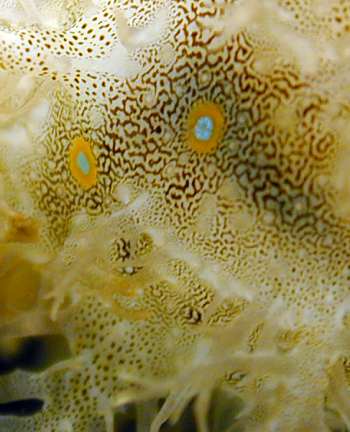
Dear Alison,
This is Bursatella leachii. Its a close relative of Stylocheilus, but grows quite a bit larger. Thanks for these great photos which show the branched papillae and the 'eye' spots very well
Best wishes,
Bill Rudman
Is the genus Barnardaclesia valid?
February 2, 2006
From: Carlo Magenta Cunha
Dear Bill,
I would like to know about genus Barnardaclesia. Is it a valid genus in the Aplysiidae? This genus is very similar to Bursatella. Eales (1952) describes Barnardaclesia cirrhifera with anatomy references.
-
Eales, N.B.1952. On Barnardaclesia cirrhifera (Q. & G.). Proceedings of the Malacological Society of London, 29(2/3): 71-79 p.
Congratulations for web site!
Cheers.
Carlo M. Cunha
carlomagenta@gmail.com
Cunha, C.M., 2006 (Feb 2) Is the genus Barnardaclesia valid?. [Message in] Sea Slug Forum. Australian Museum, Sydney. Available from http://www.seaslugforum.net/find/15721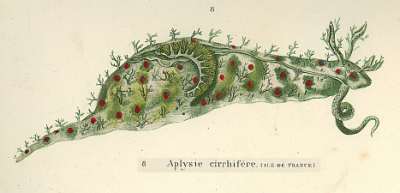
FIGURE: Plate 24; figure 8. Aplysie cirrhifére [Aplysia cirrhifera]. Quoy, J.R & Gaimard, J.P (1832) Atlas.
Dear Carlo,
Nellie Eales was a prolific worker on the aplysiids but unfortunately most of her work was done from preserved specimens she found in museum collections. Anyone with any experience with aplysiids will know that once preserved they lose their colour and much of their natural shape, and unless they are extremely well narcotised, they almost inevitably contract on preservation which distorts their shape, and usually rearranges their internal organs. Although at on stage she mentioned the necessity of describing the living shape and colour of species, she never put that into practice herself.
The genus Barnardaclesia was proposed by Engel & Eales (1935) who chose Aplysia cirrhifera Quoy & Gaimard, 1832 as the type species. In brief, members of the genus were considered larger than Stylocheilus and smaller than Bursatella, and to have a long slender 'tail' like Stylocheilus but to differ in having the genital opening just inside the mantle cavity rather than just outside as found in Stylocheilus. However Bursatella also has the genital opening just inside the mantle cavity. Most authors (MacNae, 1962; Marcus, 1972) consider Barnardaclesia to be a synonym of Bursatella, but some, notably Bebbington (1974, 1977) don't really address the question. Aplysia cirrhifera was based on specimens from Mauritius, and MacNae later identified animals from South Africa with that name, but placed them in Bursatella. It is possible there may be a distinct species, but considering the variability found in Bursatella leachii, it is unlikely. It is unfortunate that Engel & Eales felt the need to propose a new genus for a few preserved specimens.
-
Bebbington, A. (1974) Aplysiid species from East Africa with notes on the Indian Ocean Aplysiomorpha (Gastropoda: Opisthobranchia). Zoological Journal of the Linnean Society, 54: 63-99.
-
Bebbington, A (1977) Aplysiid species from Eastern Australia with notes on the Pacific Ocean Aplysiomorpha (Gastropoda: Opisthobranchia). Transactions of the Zoological Society of London, 34: 87-147.
-
Macnae, W. (1962) Tectibranch Molluscs from Southern Africa. Annals of the Natal Museum, 15(16): 183-199.
-
Marcus, Ev. (1972) On the Anaspidea (Gastropoda: Opisthobranchia) of the warm waters of the western Atlantic. Bulletin of Marine Science, 22(4): 841-874.
-
Quoy, J.R & Gaimard, J.P (1832) Voyages de decouvertes de l`Astrolabe pendant les annees 1826-1829 sous le commandement de M.J. Dumont d`Urville. Zoologie 2. Atlas. Mollusques Plates 1-93.
-
Quoy, J.R & Gaimard, J.P (1832) Voyages de decouvertes de l`Astrolabe pendant les annees 1826-1829 sous le commandement de M.J. Dumont d`Urville. Zoologie 2: 1-320.
Best wishes,
Bill Rudman
Bursatella leachii from Gulf coast, Florida
August 30, 2005
From: Bryan Wanderlingh
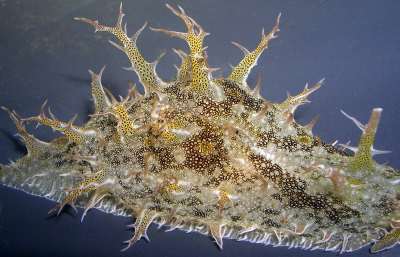
Hi Bill,
Following my recent message [#14558]: Just wanted to submit a better picture of Bursatella leachii from off the coast of Florida, Gulf side.
Locality: Sarasota, Florida, Gulf of Mexico. Depth: 2 Feet. Length: 2.5 inches. July 2005. Open shoreline, sand interspersed with shells. Photographer: Bryan Wanderlingh
Bryan Wanderlingh
knightscitadel@yahoo.com
Wanderlingh, B., 2005 (Aug 30) Bursatella leachii from Gulf coast, Florida. [Message in] Sea Slug Forum. Australian Museum, Sydney. Available from http://www.seaslugforum.net/find/14650Thanks Bryan,
Best wishes,
Bill Rudman
Bursatella leachii aggregation in Trinidad, West Indies
August 25, 2005
From: Sherri Deaver
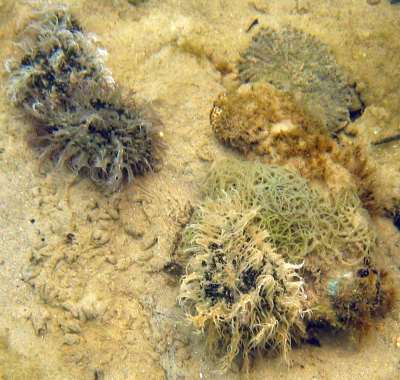
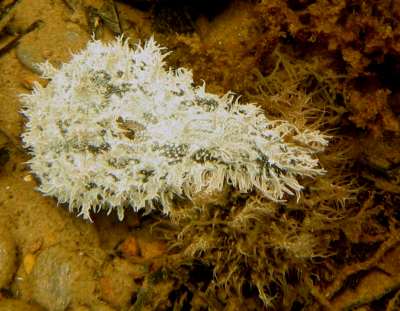
We just returned from a dive/snorkel trip to the NW coast of Trinidad (Caribbean) where we observed a brief but dense aggregation of Bursatella leachii. In six years of diving in this area we had never seen any B. leachii. On 26 July 2005 we saw a single individual. On 27 July we saw another single ragged sea hare at a different dive site. On 28 July we saw hundreds scattered widely in the shallows near shore. Distribution was as singles, in lines of 2-4 and mounds of 4-8 touching individuals. All were seen in the shallows (1-6 ft deep) in green water with sand and rubble bottoms, in the morning between 9-12 am and the water temperature averaged 82 degrees F. None were noted below 6 ft deep. The sea hares varied in color. White, pink, green, brown and greenish gray individuals were noted. On 2 Aug we found many B. leachii (20-40) in one small area at 2-4 ft. deep, but they were totally absent elsewhere. The concentrations noted on 28 July and 2 Aug. occurred at the same dive site. From 3 Aug. to 10 Aug. we dived several sites (including those where we found the concentration on 28 July/2Aug) and saw no sea hares anywhere. Judging from the information on the Sea Slug Forum, we assume we observed a mating aggregation. Does ragged sea hare mating usually occur in aggregation like this or is this unusual? Are they tied to lunar or other temporal cycles? If we ever see such an aggregation again, are there other factors we should be recording? Other photos and exact site locations (lat/longs) can be provided upon request.
Locality: Muck Dive sites on North shore of Trinidad, West Indies
Tropical Western Atlantic. Depth: 1-6 ft. Length: var., 4-7 inches. 26 July to 2 August 2005. fine sand and rubble, green water. Photographer: Sherri Deaver
Sherri Deaver
ksdeaver1@bresnan.net
Deaver, S, 2005 (Aug 25) Bursatella leachii aggregation in Trinidad, West Indies. [Message in] Sea Slug Forum. Australian Museum, Sydney. Available from http://www.seaslugforum.net/find/14624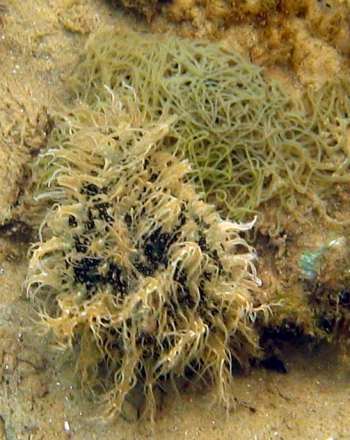
Dear Sherri,
Thanks for this interesting observation. In both your photos there are typical tangled strings of eggs [see close-up alongside] which is certainly evidence they are mating and breeding, but whether we should call this a 'mating aggregation' I am not sure. In the Forum I have a Fact Sheet on mass mortality, which is I think part of the same cycle. My feeling is that sometimes, somewhere, large numbers of veligers settle out of the plankton and meet optimal environmental conditions. In a few weeks they quickly grow to maturity, mate and die. Death can be caused by old age, running out of food, or physical conditions such as excessive heat in shallow water or a bad storm - or a mixture of all these. I have mentioned seeing a huge aggregation like this of Bursatella leachii in New Zealand at a place I visited often. usually there would be a few Bursatella around but only once did I see an aggregation like this.
You ask if they usually aggregate like this for breeding. My feeling is that they don't 'aggregate' in the sense of all assembling in one place for the purpose of breeding. What we see is a whole population which settled out of the plankton as a large group and have all survived together through their life cycle. Other years only a few larvae will settle out of the plankton and in those cases mating will only occur if the few 'settlers' cross paths. The term 'cross paths' is very appropriate because many sea slugs seem to find their partners, and sometimes their prey, by following the mucus trails that are produced as they crawl along the substrate. As you will have read on the Forum these Sea Hare aggregations are a fascinating sight. I guess we can be fortunate they are all herbivorous. It would be a bit devastating if they were like the army ants of Africa and Sth America.
Best wishes,
Bill Rudman
Bursatella leachii from Florida
August 15, 2005
From: Bryan Wanderlingh
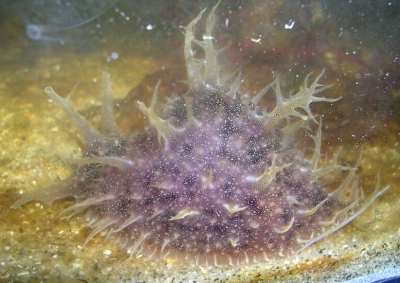
Could someone identify this for me
Locality: Caspersen Beach, Florida, Gulf of Mexico. Depth: 2 Feet. Length: 3 inches. 15 September 2004. Sand Shell Mix turning to sand deeper out
Photographer: Bryan Wanderlingh
Bryan Wanderlingh
knightscitadel@yahoo.com
Wanderlingh, B., 2005 (Aug 15) Bursatella leachii from Florida. [Message in] Sea Slug Forum. Australian Museum, Sydney. Available from http://www.seaslugforum.net/find/14558Dear Bryan,
This is Bursatella leachii, a sea hare which is found in many parts of the world, often in large numbers. Have a look at the Fact Sheet and acompanying messages for more information
Best wishes,
Bill Rudman
Bursatella leachii from Western Australia
July 11, 2005
From: Melvyn Lintern
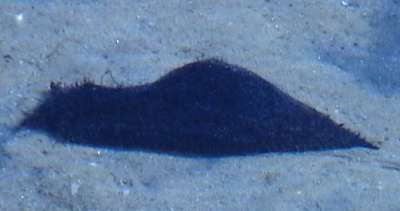
Hi Bill,
Enclosed are images of sea slugs I photographed in February 2005 that I'd like an ID of. There may be two species as the one in lower left photo is paler and larger.
Locality: Wilson Inlet, Western Australia. Depth: 1 m. Length: 10 to 20 cm. 2nd February 2005. Estuarine, sandy inlet. Photographer: Mel Lintern
Cheers,
Mel
Mel.Lintern@csiro.au
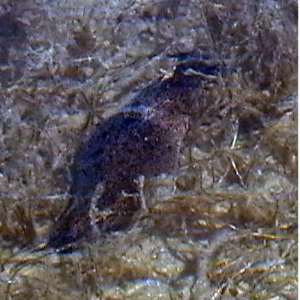
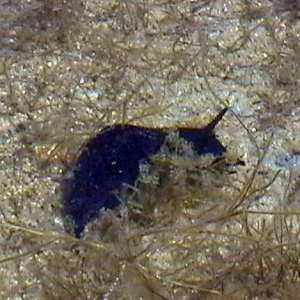
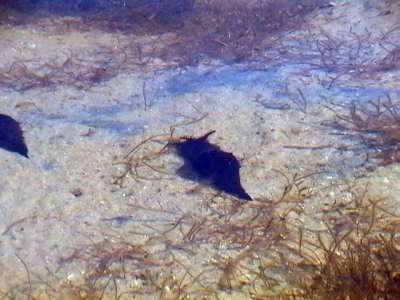
Dear Mel,
This is the Bursatella leachii. It is a faily common estuarine sea hare in many parts of the world. The colour difference is not unusual. Like many sea hares this species is often found in large numbers [see Mass Mortality], especially when they reach adulthood and are more visible, or leave the shelter of the grass beds as the two in your photo alongside have done. This species, and the much smaller Stylocheilus striatus feed on a layer of blue-green algae [or cyanobacteria] rather than the normal sea hare diet of macroalgae.
Best wishes,
Bill Rudman
Re: Albino form of Bursatella leachii
May 31, 2005
From: Dong Bum Koh
Dear Bill,
Concerning the photo of albino Bursatella [message #13857], the photographer, Jin Soo Kim, has reported to me, that at that time, he observed about 10 animals of the albino form of Bursatella leachii within an area with a radius of about 10 m.
Best regards,
Dong Bum Koh
drkoh@seasee.co.kr
D.B. Koh, 2005 (May 31) Re: Albino form of Bursatella leachii. [Message in] Sea Slug Forum. Australian Museum, Sydney. Available from http://www.seaslugforum.net/find/13900Thanks Koh,
Bill Rudman
Another Bursatella leachii with eggs
May 31, 2005
From: Dong Bum Koh
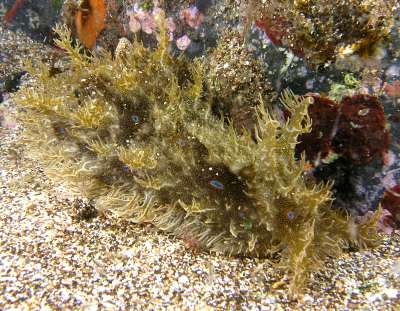
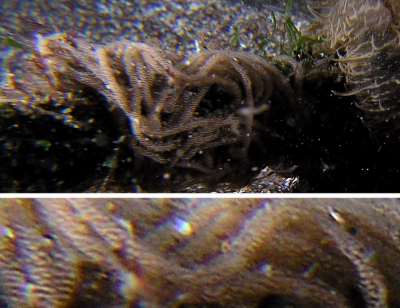
Dear Bill,
To accompany my other message [#13857] here are some photos of another Bursatella leachii with its eggs.
Locality: Hwa Soon. Jeju island, South Korea. Depth: 4 m. Length: approx 50 mm . Dec. 2004. Sandy bottom. Photographer: Byung Ro Yun
Best wishes,
Dong Bum Koh
drkoh@seasee.co.kr
D. B. Koh, 2005 (May 31) Another Bursatella leachii with eggs. [Message in] Sea Slug Forum. Australian Museum, Sydney. Available from http://www.seaslugforum.net/find/13902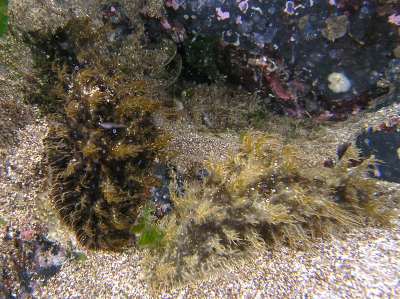
Dear Koh,
Thanks for these photos. The two animals in the photo alongside show some of the considerable colour variation found in this species.
Best wishes,
Bill Rudman
Albino form of Bursatella leachii
May 27, 2005
From: Dong Bum Koh
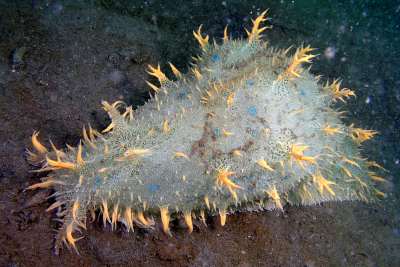
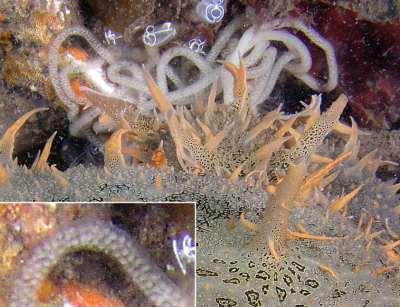
Dear Bill,
Here are some photos of what is perhaps an albino form of Bursatella leachii. But I'm not sure. Please let me know about this animal?
Locality: Seogwipo, Jeju Is.. Sth Korea. Depth: 6 m. Length: 50 mm (?). Apr. 2004. Muddy bottom. Photographer: Jin Soo Kim
Best regards,
Dong Bum Koh
drkoh@seasee.co.kr
D.B. Koh, 2005 (May 27) Albino form of Bursatella leachii. [Message in] Sea Slug Forum. Australian Museum, Sydney. Available from http://www.seaslugforum.net/find/13857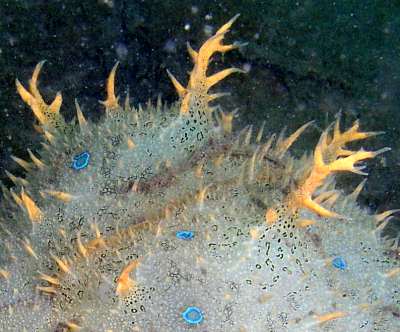
Dear Koh,
Yes this is a colour form of Bursatella leachii which is lacking much of the dark pigmentation. I have certainly seen a range of colour forms, but no one quite as spectacularly coloured as this. In some animals blue spots and rings are very prominent while in others they are absent or not very obvious. Similarly the papillae sometimes have yellow or brownish tips, and other times they don't.
Best wishes,
Bill Rudman
Bursatella leachii - another colour form
May 27, 2005
From: Dong Bum Koh
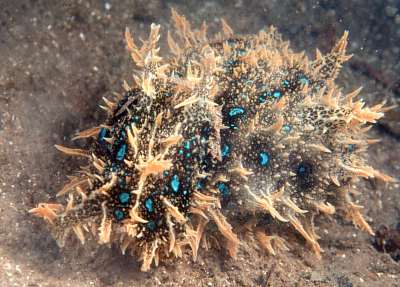
Dear Bill,
To accompany my other message [#13857] here is a photo of another Bursatella leachii.
Hwa soon, Jeju Is, Sth Korea. 5m. Muddy bottom. May. 1994. Photographer : Dong Bum Koh
Best wishes
Dong Bum Koh
drkoh@seasee.co.kr
D.B. Koh, 2005 (May 27) Bursatella leachii - another colour form. [Message in] Sea Slug Forum. Australian Museum, Sydney. Available from http://www.seaslugforum.net/find/13858Thanks Koh,
Bill Rudman
Bursatella leachii - an aquarium tale
May 12, 2005
From: Lori Doyle
I have been having a horrible problem with green hair algae. I went to a new fish store to buy some chemical treatment for the problem and they told me a 'Hare Slug' is the best answer, so I purchased it. It seems to be the one pictured on the top of the Bursatella leachii page.
I have had it for almost a week and it has been devouring the algae! I came to your site to find out what to feed it once all the algae was gone. Wow did I get educated! But I am confused to the fact that my slug IS eating, and is eating VERY WELL. So as long as my slug keeps eating, that makes me feel good that I didn't purchase an animal just to have it die.
Now, much to my dismay, I came home from work yesterday to find the slug's head caught in the filter of one of my power heads! I promptly cut the power in order to rescue the slug. As soon as I moved the power head, the slug expressed the purple ink, and a ton of it! Luckily I was able to gently shake the slug loose, all the while atttempting to minimize the ink spread by containing it in a bowl (the power head was close to the surface).
Once freed, I placed the slug, and a handful of algae in a bowl. No matter where the algae was located, the slug would move towards it and hide it's head in the algae. After about an hour, I replaced the slug back into the aquarium (I could not keep a proper temperature in the bowl). So far the slug seems to be ok. It crawled across the tank over to an algae patch and once again hid it's head. So I am praying that the trauma is not fatal, especially since I have a slug that has actually been easting in my tank!
Length: 5 inches . Purchased 25 April 2005
Thanks!
Lori Doyle:
Tursiops2@aol.com
Dear Lori,
Keeping aquaria is always exciting. Sea Hares are quite good aquarium animals and as you have found they are fairly hardy. Hopefully your Bursatella has survived its encounter with the filter,
Best wishes,
Bill Rudman
Bursatella leachii from Brazil
February 16, 2005
From: Vinicius Padula
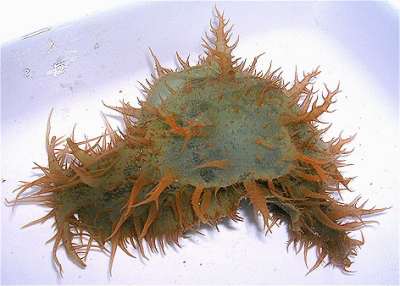
Dear Bill,
There is another Opisthobranch from Recife in Brazil. I think it is a variation of Bursatella leachii. It occurred with another animal (35 mm) with blue spots [see message #13129] in the same mangrove connected to the sea.
Locality: Pernambuco, Recife, Brazil, Mangrove. Depth: 1 m, Length: 100 mm. 5 February 2005. In sediment. Photographer: Vinicius Padula
Best Regards,
Vinicius Padula
viniciuspadula@hotmail.com
Padula, V., 2005 (Feb 16) Bursatella leachii from Brazil. [Message in] Sea Slug Forum. Australian Museum, Sydney. Available from http://www.seaslugforum.net/find/13150Dear Padula,
Thanks for this photo. It is great to see colour photos of these animals from Brazil which we previously only knew from the black & white ink drawings of the Marcuses. I note Eveline Marcus (1972} saw great numbers of Bursatella leachii in Recife in January 1972, and she reported that Marc Kempf found a similar concentration of spawning and copulating animals in October 1968.
- Marcus, Ev. (1972) Lista de Opisthobranchia (Mollusca, Gastropoda) coletadas pelo Laboratorie de Ciencias do Mar, Recife, Brasil. Trabalhos Oceanograficos Universidade Federal de Pernambuco, 13, 71-82.
- Marcus, Ev. (1972) On the Anaspidea (Gastropoda: Opisthobranchia) of the warm waters of the western Atlantic. Bulletin of Marine Science, 22(4): 841-874.
Best wishes,
Bill Rudman
Bursatella leachii? from Venezuela
February 10, 2004
From: Sylvia Grune
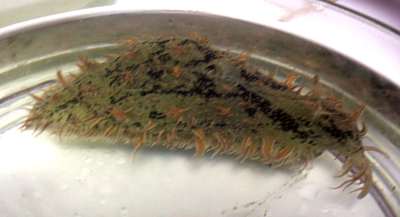
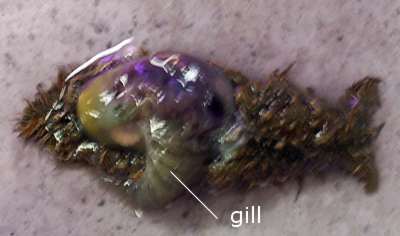
We found this animal in an aquaculture tank. At present there is a real plague in this tank and they are reproducing. We have problems identifying this animal because it doesn´t have a shell or mantle cavity but it does have a pallial cavity.
The "branchial appendix" are fully retractable. This animal have very reduced parapodia and don´t swim. We think they eat algae from the walls of the tanks but we aren´t very sure. Please if you can give us some orientation we will be very grateful.
We think it can be of the genus Bursatella, Dolabrifera or Dolabella. Perhaps Bursatella leachii?
P.D.: the animal is approx. 7 to 8 cm alive and shrinks to 5 cm afer death.
Sylvia Grune
Maragarita Island, Venezuela
sylvia_grune@yahoo.com.mx
Grune, S., 2004 (Feb 10) Bursatella leachii? from Venezuela. [Message in] Sea Slug Forum. Australian Museum, Sydney. Available from http://www.seaslugforum.net/find/12166Dear Sylvia,
This is indeed Bursatella leachii. From some of the other messages on the Forum about this species it seems to like aquaculture facilities. Some of the earlier messages discuss Bursatella in aquaculture ponds and possible interference with the shrinp fishery in the Caribbean. [To see earlier messages, select "See all messages for this species/topic" at the bottom of your message].
Bursatella feeds on cyanobacteria, in particular, the mat-forming Lyngbya majuscula, which was formerly known as the filamentous blue-green alga Microcoleus lyngbyaceus. Also have a look at the page on the related Stylocheilus striatus, which has a similar biology.
Mantle cavity and Pallial cavity are the same thing. The organ you called the "branchial appendix" is the gill. Usually when it is fully extended, as in the photo, it is a sign that the animal is not well, probably the water is becoming deoxygenated.
I assume they came into your tank either as free-swimming larvae, or as very small crawling juveniles, on some object you have introduced. If they are a problem I guess hand removing them would be a possible solution but you don't say how large your tank is, whether it is a closed system or has circulating sea water.
Best wishes,
Bill Rudman
Bursatella leachii from Florida
January 25, 2004
From: Justin D
Dear Dr Rudman
I found a Bursatella leachii in the estuary of West Palm Beach, Florida. I am wondering if it will get along with my spiney boxfish? Also I think the fish bit a few of its little antenna things, do you think it will survive? Where do you think I can find another sea hare ?
Thankyou for the information.
Justin
flip1365@yahoo.com
Justin D, 2004 (Jan 25) Bursatella leachii from Florida. [Message in] Sea Slug Forum. Australian Museum, Sydney. Available from http://www.seaslugforum.net/find/11999Dear Justin,
I'm afraid I am not an expert on 'who gets on with who' in aquarium situations. All I can say generally is that some animals can be right little nuisances who spend all their time prodding, nudging, biting and harassing everything else. Perhaps your boxfish fits that category. Sea Hares, such as Bursatella are not very fussy aquarium guests but I guess there are limits.
Concerning where to find more Sea Hares in Florida. I would guess the place you found your Bursatella is as good place as any. Most tend to prefer quiet back waters. Have a look at the messages for Aplysia brasiliana and Aplysia morio. Both species are found in your region and some of the messages have information on where they were found
Best wishes
Bill Rudman
Bursatella leachii from Turkey
January 13, 2004
From: Umut Tural
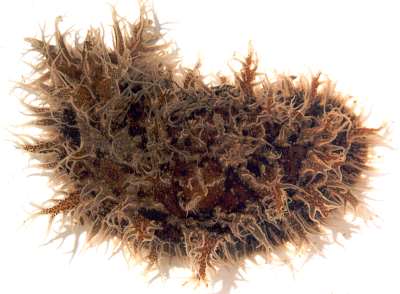
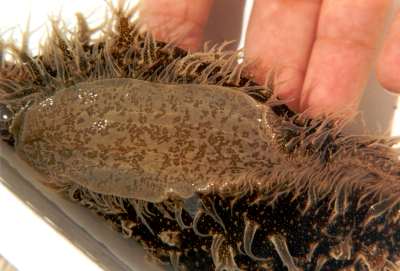
Dear Bill,
First of all I'd like to say thank you for your response before about preservation of Opisthobranchs. Here are some photos of a Sea hare I found on a sandy bottom İf I have identified it correctly this specimen is Bursatella leachii. What do you think ?
Location: Datça-Bozburun (Turkey)
Depth: 22 m
Size: 18 cm
Best regards
Umut Tural
umuttu@tnn.net
Tural, U., 2004 (Jan 13) Bursatella leachii from Turkey. [Message in] Sea Slug Forum. Australian Museum, Sydney. Available from http://www.seaslugforum.net/find/11855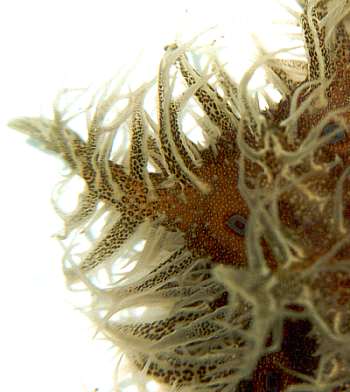
Dear Umut,
This is indeed Bursatella leachii. You can see from the close-up of one of your photos alongside why in some popular books this is called the Ragged Sea Hare.
Best wishes
Bill Rudman
Bursatella leachii defense
December 5, 2003
From: Brian
I regularly find Bursatella leachii along the Gulf of Mexico and Sarasota Bay here in Sarasota, Florida. I also find the Aplysia sp. which regularly ink. My observation/question lies in that I have yet to see Bursatella produce anything but a small "puff" of clear/opaque cloud. What is this substance? It does not seem to be any sort of distress or distraction behaviour.
Brian
BSRayburn11@aol.com
Brian, 2003 (Dec 5) Bursatella leachii defense. [Message in] Sea Slug Forum. Australian Museum, Sydney. Available from http://www.seaslugforum.net/find/11610Dear Brian,
Bursatella leachii certainly produces a purple ink. The closest to a photo I have on the Forum is in a message from Madagascar which shows traces of ink in the water. I think I have mentioned elsewhere while talking about mass strandings of these animals being forced to walk across a beach at the base of a cliff as the tide came in leaving purple footsteps along the beach where I had been forced to stand on the dying animals.
Concerning the 'small "puff" of clear/opaque cloud' you describe. That is possible from the Opaline Gland, which I describe on the Sea Hare Ink page.
Most sea hares produce both types of secretion, but there is no good evidence to suggest that its purpose is defensive
Best wishes
Bill Rudman
Re: Bursatella leachii from Madagascar
August 21, 2003
From: Franck Ducharne
Dear Bill,
Thank you very much indeed for your quick answer, that's very nice from you.
Would you have information or orient me towards specific sites about the feeding regime of Bursatella? I found them in earthern shrimp culture ponds. Can it have any effect on the culture environment? Positive or negative? Looking at the faeces I could only find blue-green cells (Oscillatoria type). Are they cyanophycae eaters?
I will let you know if I observe something interesting.
Looking forward to your answer,
Best regards
Franck Ducharne
franck.ducharne@unima.mg
Ducharne, F., 2003 (Aug 21) Re: Bursatella leachii from Madagascar. [Message in] Sea Slug Forum. Australian Museum, Sydney. Available from http://www.seaslugforum.net/find/10795Dear Franck,
Messages in the Forum are sorted, so that where possible, those relevant to a particular species, or topic, are collected together. So if you select "See all messages for this species/topic" at the bottom of your message you will get all the messages on Bursatella. Some of these discuss this species in aquaculture ponds and possible interference with the shrinp fishery in the Caribbean.
As you thought Bursatella feeds on cyanobacteria, in particular, the mat-forming Lyngbya majuscula, which was formerly known as the filamentous blue-green alga Microcoleus lyngbyaceus. Also have a look at the page on the related Stylocheilus striatus, which has a similar biology
Best wishes,
Bill Rudman
Bursatella leachii from Madagascar
August 18, 2003
From: Franck Ducharne
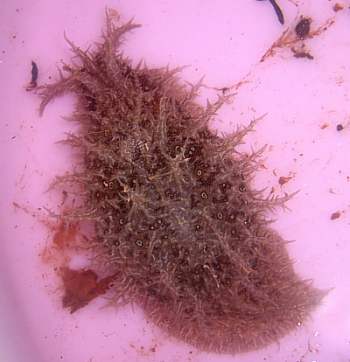
Dear Bill,
I found this seaslug which I'd like to identify. I found it on the west coast of Madagascar, in shallow water in a clay area in an estuary.
Thank you very much for your help
Best regards,
Franck Ducharne
franck.ducharne@unima.mg
Ducharne, F., 2003 (Aug 18) Bursatella leachii from Madagascar. [Message in] Sea Slug Forum. Australian Museum, Sydney. Available from http://www.seaslugforum.net/find/10769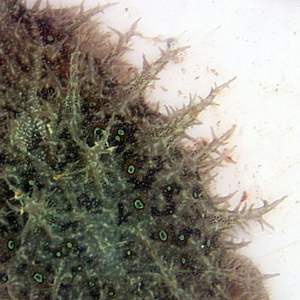
Dear Franck,
This is a Sea Hare called Bursatella leachii. If you look at the Fact Sheet, and the other mesages on this page you will see that this species is found throughout the world. There are slight differences in colour and shape in different geographic regions, which have been considered 'subspecies' by some workers, but we still have a lot to learn about this species before we can use subspecies with any confidence.
I guess the purple colour in the water is from the purple ink many species of Sea Hares produce, often when stressed or damaged. I have included a close-up alongside - with ink removed - to show the characteristic branched papillae on the back, and the eye-spots [ocelli], which often form part of the colour pattern in this species.
Best wishes
Bill Rudman
Bursatella leachii from Tunisia
April 30, 2003
From: Anis
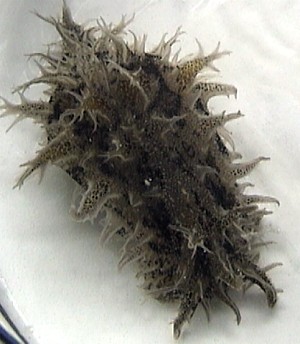
Dear Bill,
I found this sea slug in a coastal lagoon, "Lac de Tunis" in Tunis, Tunisia, North Africa. Depth: 0 to 1m some time between January and March, 2003.
Can you identify it please.
Thanks,
Anis.
Dear Anis,
This is just what you would expect in a coastal lagoon. This is Bursatella leachii, a Sea Hare which is commonly found in coastal lagoons where it feeds on cyanobacteria, which we used to call blue-green algae, which form a thin layer over the mud and sand on sheltered shores. For further information about this species, have a look at the many messages on this page, from many parts of the world.
Best wishes,
Bill Rudman
Bursatella leachii from Croatia
April 10, 2003
From: Adam Petrusek
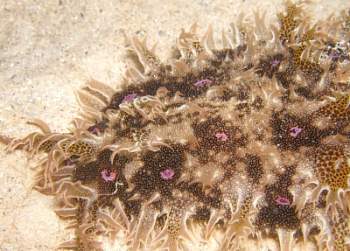
Dear Bill,
We would like to know what this colourful creature could be. It was photographed by our friend in the Adriatic sea (Croatia) on a sandy bottom some 25 m deep. The size of the whole thing (which we assign to nudibranchs but we don't really know) was probably quite over 10 cm (although we do not have exact data on that).
Could you help us?
Adam Petrusek & Lucie Jurickova
Charles University, Prague
petrusek@cesnet.cz
Petrusek, A., 2003 (Apr 10) Bursatella leachii from Croatia. [Message in] Sea Slug Forum. Australian Museum, Sydney. Available from http://www.seaslugforum.net/find/9643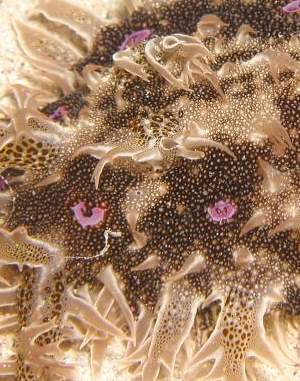
Dear Adam & Lucie,
This is Bursatella leachii. It is not a nudibranch, but it is a closely related sea slug of the Order Anaspidea - the Sea Hares. As you photographer friend has demonstrated most Sea Hares are an awkward size to photograph - too big for macro work and too small for no special lens. So we have many photos of half a sea hare.
I have included a close-up of the photo alongside so you can see some of the detail of the papillae and the colour pattern. Its a section through the front of the animal so you can see the left eye and rhinophores [head tentacles]. The eye is a little black speck in a slightly larger white spot. It is about midway between the two pinkish spots in the middle of the photo. When you find the eye, the left rhinophore is the object just above it and to the right. It is short with large tapering papillae on its front and back edges. The right rhinophore looks very similar and is further up the photo.
As you will see if your read the Fact Sheet, and other messages, Bursatella is found throughout the world, and is considered by some to have a number of geographic subspecies differing slightly in colour and the degree of 'hairiness'.
Best wishes,
Bill Rudman
Bursatella leachii from Florida
March 3, 2003
From: Linda Ianniello
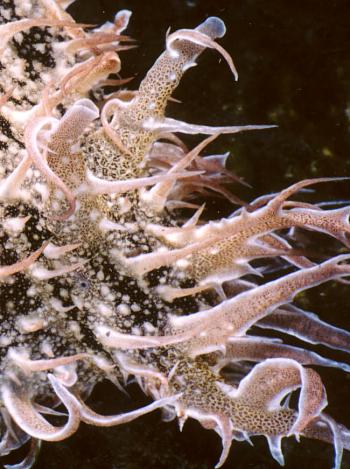
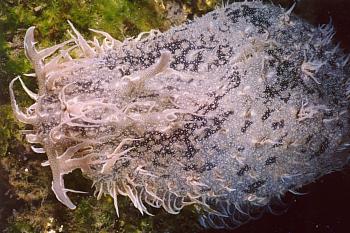
Dr. Bill
- there are quite a few postings about mass mortality in Florida, but not many pictures. This past week, there were quite a few Bursatella leachii in the shallows of a canal off the Intracoastal, laying eggs. Here are two shots showing the different colors and textures, and a shot of the eggs. I was using a 1:3 framer, and they were too large, so I took "head shots" to try and get detail of the rhinophores, etc.
Location: Intracoastal waterway at Boca Raton, Florida.
Date: February 26, 2003
Depth: 1 to 4 feet
Best Regards,
Linda Ianniello
lindai@us.ibm.com
Thanks Linda,
Bursatella doesn't look its best in photos - a bit like a wet long-haired dog. As you have shown however, when you look at it closeup, the detail is quite spectacular. For those of you interested in the detail, the upper photo shows the head of a dark animal from the right side. If you look carefully almost directly below the right rhinophore [head tentacle] you will see a black spot, which is its right eye.
Best wishes,
Bill Rudman
Bursatella leachii from Florida - egg mass
March 3, 2003
From: Linda Ianniello
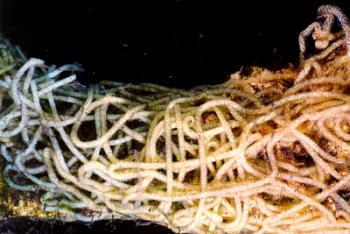
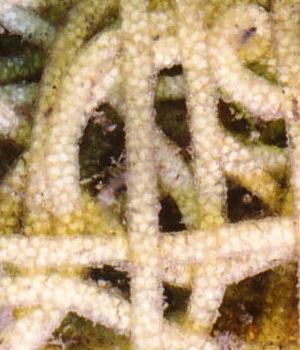
Dear Bill,
To accompany my earlier message about Bursatella leachii in Florida, here are some photos taken at the same time showing the different colors and textures, and a shot of the eggs.
Location: Intracoastal waterway at Boca Raton, Florida
Date: February 26, 2003
Depth: 1 to 4 feet
Best Regards,
Linda Ianniello
lindai@us.ibm.com
Ianniello , L. , 2003 (Mar 3) Bursatella leachii from Florida - egg mass. [Message in] Sea Slug Forum. Australian Museum, Sydney. Available from http://www.seaslugforum.net/find/9331Thanks Linda,
Bill Rudman
Bursatella leachii question
February 12, 2003
From: Cheri
I am yet another AP Biology student trying to figure out how to do the infamous Bio question related to the distribution of the Bursatella leachi. I read your Forum and I was able to write my essay. I also learned a lot about the sea slug along the way. I really appreciate this site. Again, thank you so much.
Cheri
cheriraffo@hotmail.com
Dear Cheri,
I'm glad to hear that the Forum not only helped you write your essay BUT also taught you a lot about the sea slug along the way! What more could I ask.
Good Luck with your studies,
Bill Rudman
Bursatella leachii from Chek Jawa, Singapore
January 31, 2003
From: Ria Tan
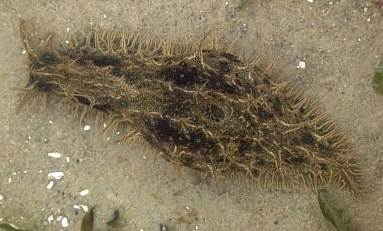
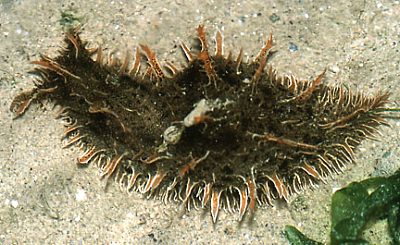
Dear Bill,
Here ia another animal from the intertidal flat at Chek Jawa, Singapore. Upper Photo: Ria Tan
Lower Photo: Alan Yeo
Best wishes,
Ria Tan
tanria@singnet.com.sg
Tan, R., 2003 (Jan 31) Bursatella leachii from Chek Jawa, Singapore. [Message in] Sea Slug Forum. Australian Museum, Sydney. Available from http://www.seaslugforum.net/find/9049Dear Ria,
This is a Sea Hare, Bursatella leachii, which is sometimes found in very large numbers. It feeds on a cyanobacteria, which we used to call blue-green algae, which forms a thin film over the mud and sand on sheltered shores. For further information about this species, have a look at the many messages on this page, from many parts of the world.
Best wishes,
Bill Rudman
Bursatella leachii? from Florida
September 12, 2002
From: Jeremy Catches
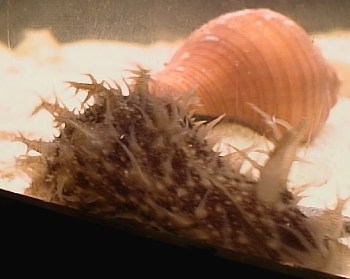
Hi,
I found these washed up on the beach in Pensacola, Florida [USA] on the Gulf Coast. They were still alive so I took 2 home and put them in my tank. They laid what I belive is eggs on one of my rocks (pictured). Will they be ok to keep in my tank or will they multiply to fast? I think my dogfish has eaten one because today I could only find one. Also do they have stingers, because my dogfish has a mark on his eye that looks like a sting.
Thanks,
Jeremy
catches@bellsouth.net
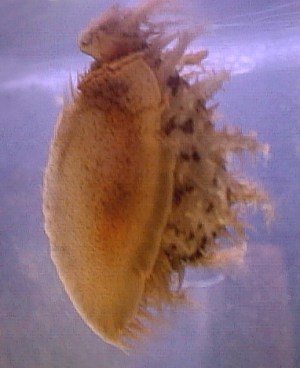
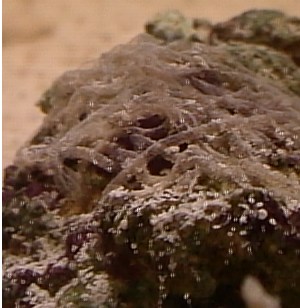
Dear Jeremy,
These are the Sea Hare Bursatella leachii. A couple in your tank would probably be ok, and even though they have layed eggs, overpopulation should not be a problem as they go through a planktonic larval stage, so are unlikely to survive in a tank environment. Sea Hares don't have any stinging cells so any marks on your Dogfish can't be blamed on them. I suspect your Dogfish might eat the Bursatella however.
Best wishes,
Bill Rudman
Re: Bursatella? from Florida
August 16, 2002
From: Jan Clark
Dear Bill,
Thank you so much for your answer. The Bursatella leachii plei picture was exact. . My kids had gone to bed, but I pulled them out to see the picture and ID ... much excitement! The purple liquid in John's photo looked exactly the shade we saw on the white sandy beach when my curious four year old poked at one. Thanks for your help. I imagine our next beach trip will find them poking around looking for sea slugs in addition to crabs and clams.
Jan
Beitun2@aol.com
Clark, J., 2002 (Aug 16) Re: Bursatella? from Florida. [Message in] Sea Slug Forum. Australian Museum, Sydney. Available from http://www.seaslugforum.net/find/7793Bursatella leachii from eastern Australia
August 15, 2002
From: John Pogonoski
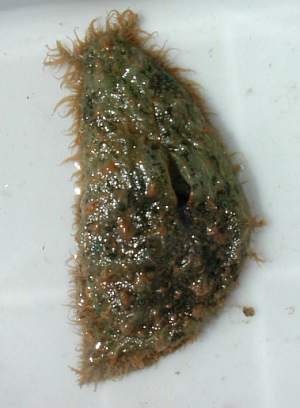
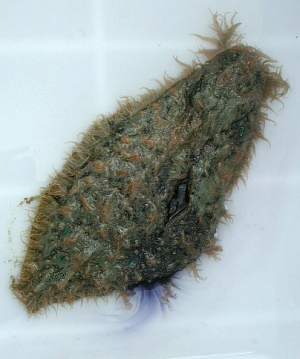
Hi Bill,
Here are some photos of Bursatella leachii from Angourie Pool in northern New South Wales, Australia [March 2002]. It was at least 15-20 cm in size. I observed about 6 individuals crawling over each other and algae, and laying large stringy egg-masses. They have many large filaments growing off the mantle and a few ocellus-like spots on the mantle too. The lower photo shows it releasing some of its purple ink.
John Pogonoski
johnpog@austmus.gov.au
Pogonoski, J., 2002 (Aug 15) Bursatella leachii from eastern Australia. [Message in] Sea Slug Forum. Australian Museum, Sydney. Available from http://www.seaslugforum.net/find/7774Thanks John,
There are often a few Bursatella and the smaller Stylocheilus striatus in that pool. I guess the calm, warm water is ideal for the growth of the cyanobacterial layer on which they feed.
Bill Rudman.
Bursatella? from Florida
August 15, 2002
From: Jan Clark
Our family went to the Gulf of Mexico on Perdido Key [Florida] this summer. Being from the midwest we had never seen many of the beach creatures before. After Bertha hit, much brown seaweed (?Sargassum?) came on shore and along with it a 3-5 " brown, gelatinous creature with tendrils (maybe 30 or so). The creature seemed to squirt a purple liquid out on the white sandy beach when touched. WOuld this be a type of sea slug? or a cucumber? We are such novices to marine life, that we have been unable to locate this in the library or on the web. Any help would be appreciated. Sorry i don't have a picture.
Jan
Beitun2@aol.com
Clark, J., 2002 (Aug 15) Bursatella? from Florida. [Message in] Sea Slug Forum. Australian Museum, Sydney. Available from http://www.seaslugforum.net/find/7781Dear Jan,
From your description of its 'trendrils' and the purple liquid, I would guess your animal is Bursatella leachii. If you have a look at the other messages on the Bursatella leachii Page you will find some photos of it from various parts of the world. In fact I am posting a message today from eastern Australia of an animal squirting out its purple ink. Have a look at the Sea Hares page for lots more information on this group of sea slugs. If your animal is Bursatella then its washng ashore with Sargassum is a coincidence.
However, one other possibility is Scyllaea pelagica which lives on Sargassum and is often found washed up with the algae. I guess its gills could be the 'tendrils' you describe, but I doubt that it grows to 5 inches long and as far as I know it doesn't produce a purple ink. Let me know if either of my 'guesses' are correct,
Cheers,
Bill Rudman
'shaggy dog' slug from Queensland
June 20, 2002
From: Caroline Deane-Caleffi
While in Noosa, Queensland, Australia last week I saw a slug close to the shore in the marina. The depth of the water was only about 50 cm and environment was one of rocks and sand in a very light and sunny spot. The slug was about 15 cm long, dark brown and covered in what appeared to be trailing weeds or algae, like a very shaggy dog. It's most distinctive markings were small - 5mm - blue rings all over its body, which seemed to get brighter when touched gently with a stick. It also puffed out a dark dusty cloud and curled itself into a ball. It was alone.
What would this be?
Caroline Deane-Caleffi
carolinedeane@hotmail.com
Deane-Caleffi, C., 2002 (Jun 20) 'shaggy dog' slug from Queensland. [Message in] Sea Slug Forum. Australian Museum, Sydney. Available from http://www.seaslugforum.net/find/7314Dear Caroline,
Your excellent description - like a shaggy dog; blue rings; puffed out a dark cloud - make this very easy to identify. It is a Sea Hare called Bursatella leachii. Have a look at the Fact Sheet and the other messages on the Bursatella leachii page to get some more information on this species. You will see that it is found worldwide and can sometimes occur in great numbers and it feeds on a thin algal-bacterial film growing on the muddy bottom. Squirting a dark cloud of 'ink' is a characteristic behaviour of all Sea Hares, and often the ink is purple or wine red in colour. Have a look at the Sea Hares page for more general information and links on Bursatella and its Sea Hare relatives.
best wishes,
Bill Rudman
Estuarine Aplysiids in eastern Australia
May 3, 2002
From: Rachel Przeslawski
First of all, I apologize for not having any pictures. I'm kicking myself for leaving the camera at home!
I was recently doing fieldwork collecting egg masses in the estuary of Lake Illawarra, New South Wales [Australia]. I stumbled upon what appeared to be 3 different species of aplysiid in a small area of mudflat about 100m inland. I found 2 very small (5 cm) slightly hairy patchy brown sea hares with tails about 2cm. I assume these are Stylocheilus striata. I also found 2 slightly hairy 10cm long yellow-brown sea hares. Finally, there were plenty of large hairy (15 cm) Bursatella leachii around.
I found 2 distinct egg masses tangled among each other and among the algae. One had wider egg ribbons of a dull yellow and orange colour. The other kind had thinner ribbons and a pale blue colour.
Although I am fairly sure the small species I saw was Stylocheilus and the large animals were Bursatella, I don't know what the intermediate sized ones could be ... could it be another morph of Bursatella? Or juvenile Bursatella? Both myself and Kirsten (my co-supervisor) are leaning towards thinking they were juvenile Bursatella since I only found 2 types of egg masses. But if so, these were quite large juveniles that didn't seem to look much like the adults!
Rachel
rap15@uow.edu.au
Przeslawski, R., 2002 (May 3) Estuarine Aplysiids in eastern Australia. [Message in] Sea Slug Forum. Australian Museum, Sydney. Available from http://www.seaslugforum.net/find/6846Dear Rachel,
I think your identifications are correct. As far as I know these are the only two 'hairy' aplysiids you are likely to encounter in your region. It would be nice to have some egg mass photos so nedxt time you're out, and have your camera, please think of us
Best wishes,
Bill Rudman
Re: Bursatella from New South Wales
March 30, 2002
From: Ian Mackey
Dear Bill,
Thank you very much for your quick response. I'm currently studying sustainable resource management and this will help me identify this species in the future.
Ian
mackeyathome@iprimus.com.au
Mackey, I., 2002 (Mar 30) Re: Bursatella from New South Wales. [Message in] Sea Slug Forum. Australian Museum, Sydney. Available from http://www.seaslugforum.net/find/6633Sea Slug? from Saratoga Bay NSW
March 25, 2002
From: Ian Mackey
Dear Dr Rudman,
Can you help me identify what I believe to be a sea slug?
It appeared more egg shaped than round approximately 110-120mm in length and 90mm wide, very good camouflage of green-brown colour, bright blue spots about 1-2mm in diameter spaced randomly no more than 20mm from each other, a pale grey colour muscular foot, and when it was alarmed it shot out purple/black coloured ink.
I found it in water approximately 160mm deep at low tide, 1400hrs. The area is Saratoga, located on the Central Coast of NSW. The body of water is called Brisbane Water which makes up a major part of the estuary system of the local area.
Thankyou for your time.
mackeyathome@iprimus.com.au
Mackey, I, 2002 (Mar 25) Sea Slug? from Saratoga Bay NSW. [Message in] Sea Slug Forum. Australian Museum, Sydney. Available from http://www.seaslugforum.net/find/6534Dear Ian,
I am pretty sure your animal is a Sea Hare, which are reknowned for squirting out red to purple ink when disturbed. From its size, estuarine location and blue spots I suspect it is Bursatella leachii. If it is that species it no doubt had a 'hairy' appearance. Have a look at Hamish Malcolm's message about them at Coff's Harbour.
There is quite a lot of information on this species from around the world in other messages on this page. Let me know if your animal is something different and I'll have to have a rethink.
Best wishes,
Bill Rudman
Seahare bloom in Coffs Harbour marina, NSW
November 29, 2001
From: Hamish Malcolm
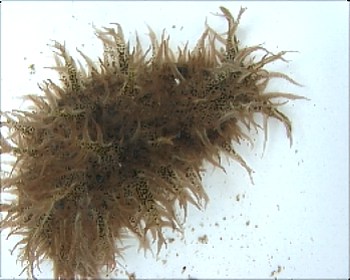
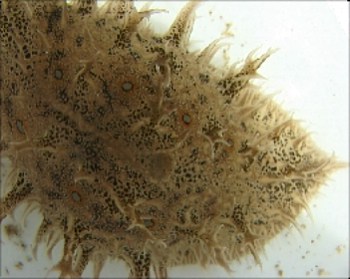
Hi Bill
Thanks for your help. I had a look at your Sea Slug Forum and the animal I described on the phone certainly looks like Bursatella leachii. This 'hairy' sea hare was first noticed by the manager of the Coffs Harbour Marina [New South Wales, Australia] a couple of days ago [November 2001]. There are presently hundreds in a fairly small area feeding over sand (on bacteria?) in the marina. The manager hadn't seen them before in all the years he has been here (nor has another bloke who has lived in the marina for the last 6 years). There has been some big swell over the last week and the outer harbour is currently being dredged which I thought might have had something to do with them 'moving' into the marina. But as you said on the phone they have probably settled as larvae and bred in the marina given the variable size of some individuals (small up to about 10cm), and have only just been noticed given rapid growth rates and short life cycles.
Anyway could you please confirm if this is Bursatella leachii. Thanks again for your help.
Cheers
Hamish Malcolm
Project Officer - Research and Monitoring
Solitary Islands Marine Park
NSW Marine Parks Authority
Coffs Harbour, NSW
Australia
hamish.malcolm@npws.nsw.gov.au
Malcolm, H., 2001 (Nov 29) Seahare bloom in Coffs Harbour marina, NSW. [Message in] Sea Slug Forum. Australian Museum, Sydney. Available from http://www.seaslugforum.net/find/5743Dear Hamish,
Yes this is Bursatella leachii. There are a number of different subspecies recognised around the world but they all have a very similar natural history which apparently includes this tendency to have irregular population explosions. It is certainly not unusual to have no sign of them for a number of years. This may be because they are very well camouflaged and so remain invisible in low densities, or it may be because they are actually absent. Because they have a planktonic larval stage, larvae can arrive from some distance away. In rare cases when larval settlement is high, and environmental conditions optimal, these 'population explosions occur.
Best wishes,
Bill Rudman
Bursatella leachii in New Zealand
October 22, 2001
From: John Buckeridge
Dear Bill
Just a quick note: One of my PhD students was involved in the "draining" of the Orakei Basin, a largish boat harbour in Auckland [New Zealand]. (This was part of a sediment build-up monitoring programme). In the middle (previously the deepest part) of the harbour was a very large, and apparently thriving population of Bursatella leachii. This was done in June this year.
Regards
John
john.buckeridge@aut.ac.nz
Buckeridge, J., 2001 (Oct 22) Bursatella leachii in New Zealand. [Message in] Sea Slug Forum. Australian Museum, Sydney. Available from http://www.seaslugforum.net/find/5496Thanks John,
Orakei Basin sounds just the right place for Bursatella - Considering the huge number of boats I have seen there, I guess the anti-fouling paints which caused so much damage to marine life a few years ago are banned in NZ.
Cheers,
Bill
Bursatella leachii - AP Biology exam
September 26, 2001
From: Stacy B.
I'm one of the many AP Biology students looking for guidance about the infamous Sea Slug (Bursatella leachii) question on the exam. I just wanted to send a quick note to let you know that I really appreciate the information your site provided. It has helped me write the necessary paragraph with some knowledge of what a sea slug is, etc. Thanks again!
Stacy
jorcy@flash.net
Stacy, 2001 (Sep 26) Bursatella leachii - AP Biology exam. [Message in] Sea Slug Forum. Australian Museum, Sydney. Available from http://www.seaslugforum.net/find/5331Dear Stacy,
Glad to be of help. Good Luck with your exams,
Bill Rudman
thank you!
August 25, 2001
From: JJ
Hi there,
I just wanted to thank you for the information provided about the Bursatella leachii and all your help with answering the infamous AP Biology question. High school teachers everywhere, apparently, have been giving students this assignment for years which gives very, very limited information on these sea slugs. I think it's a question that was once on an Advanced Placement exam years ago and it seems to be a favorite among AP Bio teachers.
Your site is very helpful and high school students everywhere appreciate it very much!
Thank you.
JJ
JJLancer@msn.com
Lancer, J.J., 2001 (Aug 25) thank you!. [Message in] Sea Slug Forum. Australian Museum, Sydney. Available from http://www.seaslugforum.net/find/5131Dear JJ,
The messages I have posted on the Bursatella question are only a small proportion of those I have received over the last few years. Thanks for the feedback.
Best wishes,
Bill Rudman
Bursatella leachii from Colombia
May 30, 2001
From: Elianny Domínguez
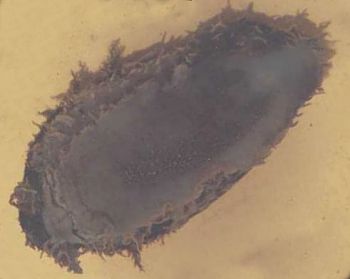
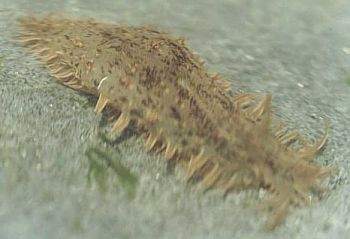
Dear Bill,
I´m a senior student of marine biology in Colombia. Right now I´m working with my collegue Alexander on nudibranchs and opistobranchs of Santa Marta, (Caribbean coast of Colombia). We are following up the investigation we did with Phanor Montoya last semester.
We have found quite a few species all ready. And we are having some trouble with the images but we would like to send them to you, to confirm the species ID since here in Colombia we hardly have any references.
About the ones I´m sending you right now I was wondering if they are morfotypes of Bursatella leachii or not??
They are from a sandy bottom at Inca-Inca Beach, Gaira Bay, Santa Marta.
Elianny Domínguez
elicelotte@latinmail.com
Domínguez, E., 2001 (May 30) Bursatella leachii from Colombia. [Message in] Sea Slug Forum. Australian Museum, Sydney. Available from http://www.seaslugforum.net/find/4420Dear Elianny,
I am glad to hear you are continuing your studies on opisthobranchs. Most populations of Bursatella leachii anywhere in the world show quite considerable variation in how 'woolly' they look. Your two photos show the extremes between quite smooth papillae (or villae) with few secondary branches and very branched papillae. Some authors have divided the world population of Bursatella leachii into geographic subspecies based partly on external shape and internal anatomy. If you follow this convention, the western Atlantic subspecies is known as Bursatella leachii plei. In the eastern Atlantic (West Africa) another subspecies B. leachii guineensis has been dscribed which differs on penial anatomy, which is not a very good character if you are trying to identify living animals or photographs.
Best wishes,
Bill Rudman
Help on Bursatella
April 12, 2001
From: Josephine
Hi
I am from New Zealand and I need to find out wot eats the sea hare Bursatella leachii for a project at school. I need to write wot they eat and wot eats them I know wot they eat but I don't now wot eats them. The lady at the library told me there was no such thing as a sea hare so I don't no where else to go
Please help!!!!!!!!!!!!!!!!!!!!!!!!!
Josephine
memarvelousme@hotmail.com
Josephine, 2001 (Apr 12) Help on Bursatella. [Message in] Sea Slug Forum. Australian Museum, Sydney. Available from http://www.seaslugforum.net/find/4170Dear Josephine,
Congratulations on finding the Sea Slug Forum. Have a look at the Bursatella leachii Page where there is plenty of information on this animal. Also have a look at the many messages which are attached at the bottom of the page for a lot more information on Bursatella from many parts of the world. [If you click on any underlined word you will move to a page on that topic].
You might like to show the lady in the library the Sea Hares Page where there is more general information on Sea Hares.
I'm afraid we don't know much about what eats them. If you go to the What eats Sea Slugs? Page you will find some information on Sea Hare predators but I don't know of any information specifically on Bursatella - which only goes to show that there is still a lot in this world that we still don't know anything about. Let's hope we don't destroy it before we get a chance to find out.
Good Luck with your project,
Bill Rudman
Bursatella leachii - behaviour
March 11, 2001
From: James
Like in earlier messages I too am faced with the AP biology assignment about Bursatella leachii. I'm sure you remember it you had so many requests for help.
The question:
A scientist working with Bursatella leachii, a sea slug that lives in an intertidal habitat in the coastal waters of Puerto Rico, gathered the following information about the distribution of the sea slugs within a ten-meter square plot over a 10-day period. Distribution of slugs within a ten-meter square plot. Midnight 8 cm between individuals; 4a.m. 8.9; 8a.m. 44.8; noon 174; 4p.m. 350.5; 8p.m. 60.5; midnight 8.
Then you have to using the data provided
• (1)summarize the pattern.
• (2)Identify three physiological or environmental variables that would cause the slugs to vary their distance from each other.
• (3)and explain how each variable could bring about the observed pattern of distribution.
• Finally choose one of the variables that you identified and design a controlled experiment to test your hypothetical explanation. Describe results that would support or refute your hypothesis.
I have read all of the other student's requests and your responses. I did discover a web site that might help http://www.neurobio.upr.clu.edu/neuroethology-98/field.htm.
It is titled: FIELD STUDIES IN PUERTO RICO and describes a study on the behaviour Bursatella. In brief it suggests that they separate during the day to feed and then regroup at night to reproduce.
Should you find more information regarding this please share it with me. If it is true that they separate during the day to feed and then regroup at night to reproduce then observing them in an aquarium setting over a peroid of time would clearly prove or disprove this idea.
What do you think?
My best to you,
James
james_elk@msn.com
James, 2001 (Mar 11) Bursatella leachii - behaviour. [Message in] Sea Slug Forum. Australian Museum, Sydney. Available from http://www.seaslugforum.net/find/3919Dear James,
Firstly thanks very much for finding this site - the project described there certainly seems to be the source of the question. In my earlier replies I had assumed that the 10 meter quadrat they described was representative of the whole population but that clearly can't be so. The quadrat must be an unrepresentative place where Bursatella retires at night. Obviously the quadrat they describe can't be surrounded by similar quadrats or there would be a traffic jam of Bursatella as they moved out of their quadrats to feed.
I have copied the relevant paragraph from the website you have discovered. The site is part of the University of Puerto Rico website and describes the Institute of Neurobiology's "Tropical Neuroethology program:"
Field Studies in Puerto Rico
The discipline of Ethology emphasizes the study of animal behavior in the field. Before the neural basis of any behavior (i.e. Neuroethology) can be studied, these behaviors must be characterized and quantified in the natural habitat of the animal. Field studies help to generate hypotheses, quantify natural behavior patterns, and verify their relevance to the animal. Some of the primary marine model systems used in neuroethological research are easily accessible in the coastal habitats of Puerto Rico. The species we are studying Bursatella leachi, the ragged sea hare, exhibits a variety of easily distinguishable behavior patterns and undergoes frequent transitions between these patterns. Some of the behavior patterns characterized in Bursatella are respiratory pumping, head waving, feeding, grazing, and copulating. Field observations are made using snorkeling and diving techniques, including underwater photography. Observations are usually made early in the morning when Bursatella are in aggregates and visibility is higher. The Bursatella display different behavior patterns depending on the time of day. During early morning, they are found in stationary aggregates ranging from 2-12 specimens. Two forms of reproductive behavior- copulation and egg laying - are predominant. Three to four hours after sunrise, these groups disperse and the animals spend the day as mobile individuals or pairs. Emission of fecal pellets (1-3 per minute) suggests that animals are engaged in a high level of feeding during the day. During the two to three hours following sunset, the animals reassemble. Based on these observations, it is currently postulated that the animals feed during the day and engage in reproductive behaviors during the night. Under the guidance of Steve Jury, students are undertaking the completion of the ethogram for Bursatella as part of the course. Other aquatic species found in the tropical waters off Puerto Rico being examined in the course are the spiny lobster Panulirus argus, Aplysia dactylomela and freshwater prawn Macrobrachium rosenbergii.
From: http://www.neurobio.upr.clu.edu/neuroethology-98/field.htm.
I also found a couple of useful references on an associated page http://www.neurobio.upr.clu.edu/neuroethology-98/faculty.htm:
• Ramos, L.J., Rocafort, J.L.L., and Miller, M.W. (1995) Behavior patterns of the aplysiid gastropod Bursatella leachii in its natural habitat and in the laboratory. Neurobiol. of Learning and Memory, 63: 246-259.
• Miller, M.W. (1997) A cellular approach to the study of complex natural behavior patterns in the ragged sea hare (Bursatella leachii), a marine invertebrate indigenous to Puerto Rico. Puerto Rico Health Sci. J., 16: 23-36.
Concerning your question about testing this behaviour in an aquarium. This type of behaviour, where an animal changes what it is doing at regular intervals, is often triggered by an internal 'body clock'. It is called an endogenous rhythm. The simplest expression of this is seen in the many animals that sleep at night and wake during the day. The 'clock' is based in the brain and its timing is kept accurate by the light/dark - day/night cycle. In many marine animals the timing of their internal rhythms is complicated by the need to respond to the tidal cycle as well. Without the constant reinforcement of both the day/night cycle and the tidal cycle their rhythms can become seriously messed up.
I remember as a student keeping the herbivorous bubble-shell Haminoea zealandiae in two aquaria. Initially the animals in both tanks would stay buried in the sandy mud at the same time the tide would be covering their natural habitat, and would be out crawling around on top of the sandy mus in the aquaria when it was low tide outside. The slugs were in tanks where they were continually under water. Over a period of about 3 weeks the match between the tidal cycle and their tank rhythm disappeared and instead their rhythm became synchronised with the day/night cycle. Surprisingly though, in one tank they all emerged from the mud at about 4 pm and in the other tank they all buried themselves at 4 pm. I can't say much about this as it was just an interesting observation rather than a controlled experiment. I suspect if you tried to test the rhythms of Bursatella in an aquarium, it would be hard to provide a 'natural' environment. If they didn't act in the same way they are reported to do in the field, then you wouldn't know whether the original observations were wrong, or whether your experimental setup was.
Thanks again for telling us about the Puerto Rico website.
Best wishes,
Bill Rudman
Sea Hare deaths in Florida continue
March 9, 2001
From: Dana Mueller
Hi,
I had thought the sea hares had finally left .. .I was down to only a couple of rescues a day, instead of hundreds ... anyway with this cold front and the north wind pounding our sea wall I haven't ventured out there to often. But I went out this afternoon and I was just sick with the mass amount of dead baby sea hares that baked in the sun. I mean more then I could count thousands of them all new babies. Piled on top of each other 2 feet wide 50 feet long. I feel so bad I had no idea this would happen. I feel like all the throwing back I did was all in vain ... anyway I thought you would like an update.
Dana Mueller
IAM2B4ME@aol.com
Mueller, D. , 2001 (Mar 9) Sea Hare deaths in Florida continue. [Message in] Sea Slug Forum. Australian Museum, Sydney. Available from http://www.seaslugforum.net/find/3948Dear Dana,
Mass mortality is not a pretty sight. Clearly from your description, in this case storms are an important factor in washing the animals up on the shore. To those of you who have never seen such an event, these up to the minute reports from Florida have certainly given us a sense of the size of some of these occurrences. Thanks to Dana, and all the other Florida residents who have sent us messages, for keeping us informed.
Bill Rudman
Re: Sea Hares in Florida
February 28, 2001
From: Dana Mueller
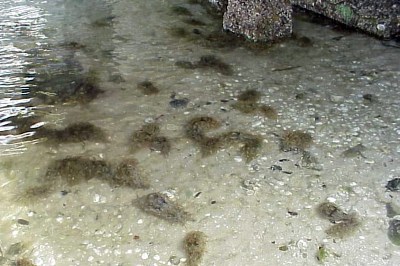
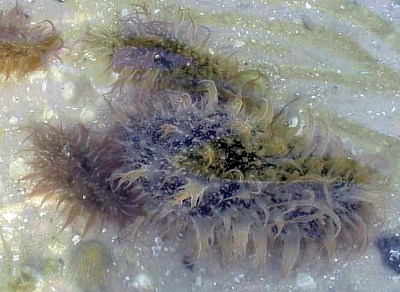
Dear Bill,
Thank you for your fast response. This first photo was taken as the tide was going out and there are not that many stranded yet. I had at least 10 feet of beach to go before it was all over. And with every foot of beach exposed there was another row of sea slugs exposed with it.
I was wondering what the Sea Hares eat and is it possible to keep a few also for a short time. Or would they hurt anything
in my tank. Also I am curious about what is there natural enemy.
Thanks,
Dana
IAM2B4ME@aol.com
Mueller, D., 2001 (Feb 28) Re: Sea Hares in Florida. [Message in] Sea Slug Forum. Australian Museum, Sydney. Available from http://www.seaslugforum.net/find/3882Dear Dana,
Thanks for the photos. Concerning my fast reponse. Usually messages have to wait their turn in an increasingly longer queue but in this case I had to respond quickly. I needed you to send me a photo and if I had waited a week or so before asking, the animals may no longer have been there for you to photograph.
In my reply to your earlier message I suggested your animal could be either Aplysia brasiliana or Bursatella leachii. Your photos are definitely of Bursatella leachii. Krystal's description, on the other hand, suggests that the animals she has observed in large numbers are Aplysia brasiliana. So it looks like you have two species of Sea Hare 'swarming' in south Florida at the moment.
I have put your messages on the Bursatella leachi page, so have a look at the information above and below your message to find out more about the species. It differs from typical Sea Hares of the genus Aplysia in not having the quite large wing-like parapodia on each side of the body, and in having the conspicuous tapering papillae all over the skin. They normally feed on a bacterial film which forms over mud and other surfaces in shallow warm water bays and seem to survive in aqauria feeding on the algal film which grows on the glass and elsewhere. They shouldn't cause any damage in an aquarium unless you have too many or they get too large.
Best wishes,
Bill Rudman
Sea Hares in Florida (1)
February 27, 2001
From: Dana Mueller
Hi.
I am from Florida and live on an open bay that channels to the Gulf of Mexico. At low tide we have a small beach. And all this past week thousands of sea slugs have been stuck on the beach at low tide. I have been throwing them back every day but again at low tide they are stuck again. They just keep crawling back toward the shore no matter how many times I throw them back out. I just came from the sea wall again and i thnk i threw in at least 100. When they are distressed they squirt a purple ink. I have touched the ink many many times and nothing has happened. They range in size and color from a lime to a large grapefruit. Should i leave them be? Or should i continue to throw them back.
Thank you very much.
Dana Mueller
IAM2B4ME@AOL.COM
Mueller, D., 2001 (Feb 27) Sea Hares in Florida (1). [Message in] Sea Slug Forum. Australian Museum, Sydney. Available from http://www.seaslugforum.net/find/3869Dear Dana
From your description it looks like your sea slug is a Sea Hare. If you look at the Sea Hare page you will find some general information. Most do indeed produce a purple ink when they are disturbed. Sea Hares are quite often found in large masses, washed up at low tide dying. Have a look at the page on Mass Mortality for more information. What is happning is that most of the population has reached old age, they have layed lots of eggs, are probably weak and have probably been washed in by tides or currents because they are too feeble to remain crawling on the sea bottom. Perhaps particularly large tides, or warm weather has made condition worse for them, but basically their washing up and dying is a natural part of their life history.
Since you found your animal in Florida it is probably Aplysia brasiliana which is a common swimming species in your part of the world. have a look at the top of this page for some photos, and have a look below you message for further messages on A. brasiliana. Krystal's message which also arrived today from Florida also suggests your animal is A. brasiliana. Another possibility is Bursatella leachii which is more compact, very 'furry' and doesn't have swimming flaps or parapodia.
Should you throw then back?. I'm afraid there is probably not much point. I suspect even the smaller ones are probably so weakened by lying there cooking in the sun, that their chances of survival are not good.
Best wishes,
Bill Rudman
Bursatella leachi plei in the Intertidal Zone?
October 19, 2000
From: Randi Bambach
I am doing a project for my marine biology class on intertidal species andI was wondering if you knew where I can find information about its vertical distribution in the intertidal, its relation to tides, its physiological limits and its activity cycles. Do you also know of any websites or books that give the general biology of this species as well?
Thank you
Randi Bambach
Iris23279@hotmail.com
Bambach, R., 2000 (Oct 19) Bursatella leachi plei in the Intertidal Zone?. [Message in] Sea Slug Forum. Australian Museum, Sydney. Available from http://www.seaslugforum.net/find/3190Dear Randi,
Have a look at th top of this page and at the other messages below yours on this page, for information on Bursatella.
It is a Sea Hare, so have a look at the Sea Hares Page for more background information.
Good Luck with your project,
Bill Rudman.
I need information on Bursatella leachii
September 3, 2000
From: Sarah Dacres
Hi,
I am an 11th grade biology student investigating Bursatella leachii. The only piece of my report i am having trouble with is finding physiological / enviromental variables affecting the distance of this sea slug from another. Please send me any possible information which would help me. Links- Pages- Essays-
Any Materials would be greatly appreciated (as long as they have information so that i can give due credit to the author/ student/ scientist/ etc.)
Sarah Dacres
Saraero16@aol.com
Dacres, S., 2000 (Sep 3) I need information on Bursatella leachii. [Message in] Sea Slug Forum. Australian Museum, Sydney. Available from http://www.seaslugforum.net/find/2961Dear Sarah,
I don't know of any good evidence to show that these animals are able to control the space between them and another Bursatella. At times I have seen them in great clusters crawling all over each other and at other times I have seen them very sparsely scattered. I have always assumed that this indicated large and small populations rather then an ability by the slug to aggregate and spread out depending on physiological and/or environmental conditions.
I have had similar enquiries to the Forum by other students over the last couple of years. I understand it is some biology examination. Have a look at messages from Ment Nguyen and Clare Kennedy. If you have a look at my comments to these, and other, earlier enquiries, you will see I have trouble understanding the question from the observations I have been given. I would be grateful if you know of any other background information so I could have a better idea of what is being asked. Perhaps there is a reference to a scientific study or article I could read?
I don't think the information, as stated by Clare Kennedy, is sufficient to make any interpretations. I am afraid that until I can get some background information and a reference to some facts I won't be able to help and I can't see how 11th grade biology students can answer it either.
Best wishes,
Bill Rudman.
Re: Bursatella from Florida
August 5, 2000
From: Douglas Anderson
Dear Dr. Rudman:
Thank you for your speedy reply. I was surprised at the speed. I guess your attempt to restrict your site to relatively local species shows how small the world has become since the internet has arrived.
I believe my creatures are Bursatella leachii plei. I just got back from several days vacation hauling them around in an ice chest (no ice) with an aerator. I put some lettuce in one day and a couple or so days later it was gone so I guess they ate it. It floats so they probably have a hard time getting to it. I need to get one of those suction cup lettuce holders.
Now I need to find out if I can put them in my salt water aquarium or can they do nasty things like some of the nudibranchs? The aquarium is what would probably be called a beginner type with primarily hardy fish and is not a reef aquarium.
You have a very interesting site. I didn't know there was so much information readily available on nudibranchs and that they are quite interesting characters.
Douglas Anderson
dummy2@wcnet.net
Anderson, D., 2000 (Aug 5) Re: Bursatella from Florida. [Message in] Sea Slug Forum. Australian Museum, Sydney. Available from http://www.seaslugforum.net/find/2831Dear Douglas,
Sea Hares are quite a good addition to an aquarium because they are herbivores and tend to graze on algal films when short of their preferred algal food. Bursatella feeds naturally on blue-green algae, but as you have found, it can make do with alternatives. You may find that boiling the lettuce, like people do for tadpoles, is useful. A more natural alternative would be the sea lettuce Ulva or some filamentous green algae from intertidal pools. I guess the only advice is not to overcrowd your tank. One or two Bursatella would be probably be best, and as they are hermaphrodites any two will lead to egg laying and food for other inhabitants of your tank.
It is unlikely that fish will cause them any problems as they produce distasteful secretions when disturbed. It is unlikely that these chemicals will foul the water, which is what happens when species of the nudibranch Phyllidia are kept in aquaria.
Best wishes,
Bill Rudman.
Sea Slug/Nudibranch? from Florida
July 31, 2000
From: Douglas Anderson
Washed up on shoreline at Panama City Beach, Florida, USA from the Gulf of Mexico. Looks like what I think a seaslug would look like. Feathery projections all over the body and sort of an ugly greenish brown. Not pretty like Australian nudibranches. I don't have a picture of one yet. Where can I go to find information on what I have?
E-mail address is USA.
Douglas Anderson
dummy2@wcnet.net
Anderson, D., 2000 (Jul 31) Sea Slug/Nudibranch? from Florida. [Message in] Sea Slug Forum. Australian Museum, Sydney. Available from http://www.seaslugforum.net/find/2788Dear Douglas,
When I started the Sea Slug Forum my aim was to concentrate on Australia and the south Pacific but that geographic focus lasted about a month - the world wide nature of the web decided otherwise.
If you want an idea of what the Forum has in the way of animals from Florida go to the SEARCH button in the yellow bar at the top of your message (or at the top of any page) and type in florida. You will get quite a list of messages and pages to look at.
You don't mention a size but from your description it is possible you have a Sea Hare. Have a look at Michelle van Deventer's message about Bursatella leachii from Florida. Have a look at the photo of Bursatella leachii pleii which is the subspecies you will find in Florida.
If this is not the animal you saw, you could try and send me a photo or a rough drawing. You could also try and obtain a copy of P. Humann's book, Reef Creature Identification, Florida-Caribbean-Bahamas.
Best wishes,
Bill Rudman.
Re: Bursatella leachii & sewage
May 30, 2000
From: Richard Willan
Dear Bill,
I have unravelled the mystery of the opisthobranchs eating "bacteria" in Auckland Harbour. You are right it is part of a natural process.
In late summer every year, larvae of the woolly sea hare Bursatella leachii settle from the plankton onto the filamentous blue-green alga Microcoleus lyngbyaceus (formerly Lyngbya majuscula) throughout harbours and estuaries in northern New Zealand. They grow very rapidly on this diet to about 90 mm; they can double their size in a week! So they soon become highly conspicuous and form aggregations centered around patches of their food and they crawl from patch to patch in groups or lines elephant-file. As the seawater temperature begins to fall in autumn these Sea Hares mate and they they all die en masse in late autumn like salmon do. Stylocheilus longicauda can be present in these feeding/breeding aggregations too, but they are always less abundant than Bursatella leachii. I studied this natural cycle in Auckland Harbour for my PhD thesis some years ago (reference below).
This autumn the water has been warmer than usual in New Zealand (like Australia) and the aggregations larger, so the mass deaths following spawning have been very noticeable and caught the attention of the media.
The matter of these sea hares eating "bacteria" can be easily explained. Formerly Microcoleus lyngbaceus was classified as a member of the Cyanophyta, but that higher classification has now changed (to Cyanobacteria) to reflect the fact that this "plant" has little in comon with other algae. Obviously someone in the media picked up the bacteria part of Cyanobacteria, and wrongly concluded the Sea Hares were eating bacteria. Like you, I know of no opisthobranch that eats bacteria proper.
Reference: Willan, R.C. (1979) The ecology of two New Zealand opisthobranch molluscs. Unpublished PhD thesis, University of Auckland, 278 pp.
Best wishes,
Richard Willan.
richard.willan@nt.gov.au
Willan, R., 2000 (May 30) Re: Bursatella leachii & sewage. [Message in] Sea Slug Forum. Australian Museum, Sydney. Available from http://www.seaslugforum.net/find/2473Dear Richard,
Thanks for the background on the life history of Bursatella in the Auckland region. As you will see from John Buckeridge's message a couple of days ago, the media appear to have unfortunately misinterpreted the information they were provided with.
I note you are using the name Stylocheilus longicauda for the lined Stylocheilus sometimes occurring in northern New Zealand. Could I refer you to the page in the Forum where I discuss why this is a misidentification, and the name we should use is Stylocheilus striata.
Best wishes,
Bill Rudman.
Re: Sea Hares & sewage in Auckland, NZ
May 27, 2000
From: John Buckeridge
Dear Dr Rudman
Joel Cayford has asked me to look at your comments. It was my comment that sparked the discussion in Auckland. Things get a little garbled en route, so here are the main points of my argument:
•1. There are very large numbers of Bursatella glauca at Long Bay, on Auckland's North Shore.
•2. The numbers are higher than I have ever seen in 20 years. Residents who have been on eastern beaches for 65 years say that this phenomenon is something they have never experienced before.
•3. The greatest numbers of B. glauca are concentrated near a stream mouth at the southern end of the beach.
•4. The stream is polluted. It has high levels of coliform bacteria. (last week, a student group recorded levels at more than a magnitude above permissable "safe" levels).
•5. It is "unseasonally warm".
•6. There are blooms of cyanobacteria and green algae in the area, and these form thin layers on the silty-muddy sea bed.
•7. The breeding time of B. glauca (at least the end of the cycle), has coincided with this.
•8. The high levels of coliform bacteria are an indication of sewage in the stream. The blooms are an indication of high nutrient levels and warmer than normal temperatures. The abundance of B. glauca reflects the above. It does not eat sewage, rather, it eats cyanobacteria and green algae films. B. glauca is a symptom of environmental degradation e.g. sewage release and other trappings of urbanisation. The local council has for years denied that there is a sewage problem. This is most unfortunate, as the evidence has been overwhelming for years. (They are now in the midst of an expensive upgrade of the system, but it is far from complete, and there is still permission to release untreated sewage into the environment under certain circumstances).
It seems that "explosions" in the numbers of sea hares does at least focus the public interest and has galvanised the Council to take "remedial action".
I await developments with interest, but cannot escape the conclusion that our council will wait for this to calm down, and then get on with other agendae.
Kind regards
John
Professor and Director
Earth and Oceanic Sciences Research Centre
Auckland University of Technology
john.buckeridge@aut.ac.nz
Dear John,
I'm glad to hear from you and to get the story clarified. As I said to Joel, I suspected the Sea Hare may have been Bursatella, which by the way now goes under the name Bursatella leachii, B. glauca being an old unnecessary name. You'll see above your message some general information on the species, and below your message there is earlier correspondence on the species, including discussions on population explosions. Various subspecies are found around the world and all of them are characterised by 'population explosions'.
Although locals often say they have never seen anything like this before this does not mean that it has not occurred regularly in the past. They just missed it. There is a note about Bursatella leachii in Willan & Morton's (1984) book on the Opisthobranchs of the Cape Rodney Marine Reserve, just north of Auckland "becomes seasonally highly abundant..". I can also remember 40 years ago holidaying on nearby Waiheke Is in the Hauraki Gulf in January, walking along beaches so crowded with washed-up Bursatella that I had to stand on them, leaving a trail of purple foot steps behind.
The point that needs to be made is that a population explosion of Bursatella does not automatically signal a sewerage problem or an environmental disaster, it is a natural phenomenon. High nutrient levels in this case may have encouraged the growth of the blue-green algal mat that Bursatella feeds on, but as the blue-green algae flourishes naturally in shallow warm bays, which are not polluted, even this would need to be tested.
I sympathise with the North Shore's environmental problems, but I think the high levels of coliform bacteria in the water is more indicative of a problem, than the humble Sea Hare, even if sometimes they do seem to breed like rabbits..
Best wishes,
Bill Rudman.
Reference: Willan, R. & Morton, J. (1984) Cape Rodney to Okakari Point Marine Reserve. Marine Molluscs. Part 2. Opisthobranchia. 1-106. University of Auckland, Leigh Marine Laboratory: Auckland.
Rudman, W.B., 2000 (May 27). Comment on Re: Sea Hares & sewage in Auckland, NZ by John Buckeridge. [Message in] Sea Slug Forum. Australian Museum, Sydney. Available from http://www.seaslugforum.net/find/2454Re: Sea Hares & sewage in Auckland, NZ
May 27, 2000
From: Joel Cayford
Hi Bill,
Thanks very much for your comments. I will try and get you a photo. There have been photos in the press. I have referred various experts and council representatives to your reply.
Regards,
Joel Cayford
jcayford@teamvideo.net
Cayford, J., 2000 (May 27) Re: Sea Hares & sewage in Auckland, NZ. [Message in] Sea Slug Forum. Australian Museum, Sydney. Available from http://www.seaslugforum.net/find/2457Dear Joel,
You'll see from John Buckeridge's message today that the Sea Hare is Bursatella.
Best wishes,
Bill Rudman.
Sea Hare that lives on sewage?
May 24, 2000
From: Amelia Wong
Hi Bill.
This site is a really informative....
But does it have any information on the Sea Hare that lives off sewage?
I'm no Sea Hare expert and have recently discovered that we have had an invasion around our local beaches of the kind that lives off sewage. I would like to find out more about it as I am giving a speech about them at my school.
Amelia Wong
amelializwong@hotmail.com
Wong, Amelia, 2000 (May 24) Sea Hare that lives on sewage?. [Message in] Sea Slug Forum. Australian Museum, Sydney. Available from http://www.seaslugforum.net/find/2439Dear Amelia,
Are you by chance from Auckland? Have a look at the message I recently answered from Joel Cayford in Auckland who also was asking about a Sea Hare that lives on sewage. I am not sure how familiar you are with the internet but if you click on any of the coloured and underlined words you will move to a page on the underlined topic.
As you will see from my reply to Joel, most Sea Hares feed on sea weeds. There are a few that feed on blue-green algae which sometimes form a mat on soft sandy or muddy bottoms, but these mats form naturally on unpolluted shores. I know of no species that feeds on sewage bacteria.
There are two ways you could help me answer your question. Firstly you could find out who said that Sea Hares feed on sewage bacteria. It would be interesting to know if they have actually seen them do this or whether they have read it in a scientific article. Secondly, can you send me a photo or even a drawing of the slug so I can possibly identify it for you.
If your question is related to the sewage controversy that Joel talks about, then it is possible that someone has said that Sea Hares eat sewage bacteria through a misunderstanding. Unfortunately misunderstandings sometimes occur when heated debates on environmental matters take place. This is unfortunate because it can lead to the wrong decisions being made.
One interesting silly 'fact' concerning Sea Hares. The Ancient Greeks use to believe that you would die if you touched a Sea Hare. Even the great philosopher Aristotle believed it was true because in those times learned people decided what was true by having long learned arguments. The person judged to have the best and wittiest argument was the winner, facts were seldom, if ever, considered necessary. Using facts and observations to test ideas about the world around us was seldom considered necessary until the 1600s when 'science' developed as a method of understanding our world. The lesson from this is that you shouldn't believe everything you are told.
If you would like to know more about Sea Hares go to the Sea Hare Page.
Best wishes,
Bill Rudman.
Sea Hares at North Shore City, New Zealand
May 16, 2000
From: Joel Cayford
There has been an explosve outbreak in Sea Hare/ Sea Slug populations along parts of East Coast Bays beaches at North Shore City, Auckland, New Zealand. They range in size from small to the size of a hand palm, and emit the dye when disturbed. No sea birds will touch them.
A local scientist claims their presence is due primarily to sewage bacteria being present in the sea water. This is a controversial matter as the local Council is strenuously rehabilating local sewer networks. Each week it tests beachwater for enterococci. For the past few months there have not been elevated levels in the vicinity of this population of Sea Hares. (The standard is 100 organisms/100ml of water).
These beaches are adjacent to urbanised landscapes. We have had a dry summer, with little or no rain.
What is the most likely set of causes for this sudden increase in Sea Hare / Sea Slug population?
Regards,
Joel Cayford
cayford@watermagazine.com
Cayford, J., 2000 (May 16) Sea Hares at North Shore City, New Zealand. [Message in] Sea Slug Forum. Australian Museum, Sydney. Available from http://www.seaslugforum.net/find/2391Dear Joel,
If you could send me a photo of the Sea Hare involved I could give you a more detailed answer. I presume you are talking about a species of Aplysia, which feed on certain species of sea weed, but it is also possible you have a population of Bursatella leachii, another type of Sea Hare, which usually feed on blue-green algae that form a layer over the bottom.
In both cases it is unlikely anything in the water column could directly affect the size of their populations, although increased nutrients might help the algae they feed on to flourish. However there is a much simpler explanation for a Sea Hare population explosion - it's normal!
For some background information on Sea Hares have a look at the Sea Hare Page. Population explosions are quite a normal feature of Sea Hare biology and it's usually when they all start dying simultaneously that people begin to mistakenly blame pollution. Rather than repeat what I have said before, have a look at my answer to an earlier message from Annie Troutman on a population explosion of Aplysia dactylomela in Florida last year. Also have a look at the messages about
A. brasiliana which is doing the same this year.
If you have a look at the page on Mass Mortality you will find links to a number of other pages and messages on the subject.
Basically, there are some years when all conditions are favourable. There is plenty of food, good larval settlement, and calm weather. Most of the juvenile Sea Hares survive settlement from the plankton and grow to maturity. At this stage they become rather obvious on the shore and when they begin to breed and die their dead and dying carcases become even more obvious as they wash up on the tide line. By coincidence there is a population explosion in at least one part of Sydney Harbour at the moment. The photo of multiple mating in Aplysia dactylomela, which I recently posted, was of animals collected from just such a 'population explosion'.
You also mention that 'no seabird will touch them'. This is not because they are diseased but because they have chemical defences to protect themselves from predators. Have a look at the pages on attack & defence and chemical defence.
Best wishes,
Bill Rudman.
Question about Bursatella leachii
May 11, 2000
From: Emily Driesman
I am a junior in high school and for an assignment I had to identify 3 physiological or environmental variables that could cause sea slugs [Bursatella leachi] to vary their distances from each other (further apart during the day, closer at night. As one of my variables I hypothesized that a decrease in the amount of carbon dioxide in the air surrounding the sea slugs could cause the slugs to move further apart. When sunlight is available, the plants and algae in the intertidal
habitat are able to carry on photosynthesis. With more sunlight as the day progresses, more photosynthseis occurs and thus less carbon dioxide is present in the atmosphere surrounding the intertidal habitat since carbon dioxide is a reactant for photosynthesis and sunlight is the energy source that drives photosynthesis. So with a decrease in carbon dioxide that is present in the day time, the sea slugs react by moving furhter apart. My teacher felt that carbon dioxide had no effect on slyg movement, and granted this is only a hypothesis of a possible variable that could affect slug movement. Do you know if carbon dioxide in fact could possibly affect slug movement?
Thank you for your help?
Emily Driesman
Emalad@aol.com
Driesman, E., 2000 (May 11) Question about Bursatella leachii. [Message in] Sea Slug Forum. Australian Museum, Sydney. Available from http://www.seaslugforum.net/find/2379Dear Emily,
If you look at the other messages below yours on this page, you will see that questions about Bursatella moving and crowding etc are regularly asked of school students. It must be in the teacher's book of nasty questions!
Firstly, although hypothesising is a necessary step in the process of discovery we call the scientific method, it is only of value if you first have made some basic observations so you know what questions to ask and what hypotheses are likely to fit the facts.
Firstly, I have asked other students who have asked questions about Bursatella just where they got the information that Bursatella are further apart during the day and closer together at night. So far no one has told me where the evidence was published. If they spread out at night and then clustered together in sea grass or algal beds during the day you could hypothesise that this was a defensive behaviour to hide from potential predators. But you say the opposite occurs which is puzzling.
secondly, about the effect of carbon dioxide concentrations in the air. Bursatella is almost always covered with water so airborne gases are irrelevant. I would think in most intertidal and shallow water situations,(except stagnant ponds), there would be enough water movement and mixture to mask any local changes in oxygen / carbon dioxide levels. Even if there are changes I don't see how it would effect the density fo the Bursatella population.
I do think it is important for you to find the source of this story of Bursatella being apart during the day and closer together at night. If you could let me know I could have a look at the research and give you my thoughts.
Best wishes,
Bill Rudman.
Frilled Sea Hare in Florida
February 28, 2000
From: Michelle van Deventer
I live on a canal system on Siesta Key in Sarasota, Florida. I noticed an incredible creature crawling around under my boat dock in only about 7 inches of water on a very muddy/silt bottom. After studying it for some time, then checking out this website, I'm pretty sure it was a Bursatella leachii plei. I hoped you could answer a few questions:
How common are these creatures in Bay areas and Intracoastal Waterways? Is it rare for them to venture into a canal systems? This was about 8 inches long, and had a thumbnail-sized opening on it's back that would regularly open and close, excreting a white pellet about the size of a peanut. What was this?
Do they normally travel in groups or is it more common to find single specimens? Are they prey to any of the bird species, such as herons or egrets?
Thank you for any additional information you can provide.
Michelle
mvande@home.com
van Deventer, M., 2000 (Feb 28) Frilled Sea Hare in Florida. [Message in] Sea Slug Forum. Australian Museum, Sydney. Available from http://www.seaslugforum.net/find/1982Dear Michelle,
I have no personal knowledge of the region you are asking about, but Bursatella leachii is certainly common in sheltered bays and estuarine regions with sand or muddy bottoms. A couple of the messages below yours on this page talk about the possible problems large populations of them cause in prawn ponds, so canals would probably be a good place to find them. To answer your questions I suspect they would be very common at some times of the year in such places. Have a look at my answer to the Lee Wiesenfeld's question where I talk about research that he records examples where local populations can reach enormous numbers and densities of 660 individuals per square metre .. enough to interfere with the local shrimp fishery.
Bursatella leachii feeds mainly on blue-green algae which can form thick mats over muddy shores and films over larger macroalgae.
The white pellet it excretes is most likely a faecal pellet. In Aplysiids the mantle cavity, shell, gill and anal papilla are hidden by the parapodia which are a flap of skin on each side of the body which fold over and meet in the midline of the back. If you have a look at the Sea Hares Page it will get a basic idea of their shape.
Do they travel in groups? They certainly are usually found in large numbers, although at times only a few animals will be found.
Do birds or anything else eat them? As far as I know nothing is commonly known to feed on them as a regular source of food. Sea Hares, like most sea slugs have glands in their skin which produce noxious or distasteful secretions which tend to deter most likely predators. Have a look at the pages on Defensive Glands in Sea Slugs and Defence in Sea Hares.
Best wishes,
Bill Rudman.
Bursatella from Colombia
February 16, 2000
From: Phanor Montoya
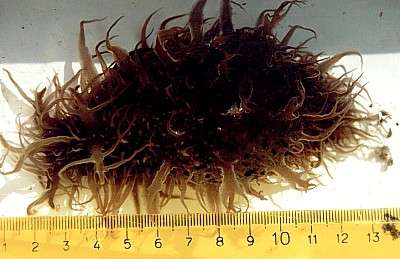
Dear Bill,
I found this Opisthobranch in the Caribbean waters of Colombia. I think it´s a sacoglossa. I heard that every year when the up-welling event is taking place (December- February)in these waters this species is easy to find. Three days ago when I was doing some snorkeling I found a thousand of them moving over the muddy bottom of the Santa Marta Bay (Colombia). I took a hundred to study them but I couldn´t find a way to fix and preserve them. I just took the picture that I am sending to you.
By the way, I would like to know what kind of nudibranch research studies are being carried out today, because I would like to do my undergradute work in this subject but I don´t know about what topic.
Thanks
Phanor Montoya
Marine Biology Student
Santa Marta, Colombia
phamont@eudoramail.com
Montoya, P., 2000 (Feb 16) Bursatella from Colombia. [Message in] Sea Slug Forum. Australian Museum, Sydney. Available from http://www.seaslugforum.net/find/1915Dear Phanor,
Your animal is not a sacoglossan. It is Bursatella leachii which is a Sea Hare. Some scientists have split this worldwide species into geographic subspecies. If we follow that proposal then your Caribbean animal is Bursatella leachii plei. Bursatella feeds on blue-green algae and the filamentous algal film found on sand, mud and hard surfaces.
There is quite a lot of information on this page about Bursatella. Have a at the Top of this Page above your message, and below your message for earlier correspondence.
It is a bit difficult to answer your question about nudibranch research, without knowing what facilities you have, or how much time you are expected to spend on your undergraduate research project. There are research workers around the world looking at may aspects of nudibranch biology including anatomy, physiology and ecology. My advice would be to find a couple of opisthobranchs which are fairly common and study their basic biology - what they eat, where they live, when they breed, what their egg mass looks like etc. And describe their anatomy.
This sort of study seems quite simple but it is seldom easy and will give you the opportunity to do a bit of dissecting, some basic observations, and some ecological work. It has the advantage of not requiring you to have access to an extensive library which would be necessary for a taxonomic study. As we know so little about the natural history of most opisthobranchs it will also give you a chance to do an original bit of science and produce some new information.
If you plan to do something like this I am sure someone will be able to identify your species if you send me some photos.
Best wishes,
Bill Rudman.
Information on Bursatella leachii
September 28, 1999
From: Dana Rygwelski
Hello,
My name is Dana Rygwelski. For my Ap biology class we are currently working in the ecology unit, we were assigned to look up about a specific type of sea slug. If you could please help me out by sending me information on Bursatella leachii it would be greatly appreciated.
Thankyou very much for your help,
Dana Rygwelski
peanut9699@yahoo.com
Rygwelski, D., 1999 (Sep 28) Information on Bursatella leachii. [Message in] Sea Slug Forum. Australian Museum, Sydney. Available from http://www.seaslugforum.net/find/1374Dear Dana,
As you were assigned the job of doing the 'looking up' I am happy to give you some clues and guidance on where to look, but it's not much training for you if I just give you the answer.
You may not realise the Forum is much more than just the messages. There are plenty of places where you can 'lookup' information. Firstly, have a look at the page on Bursatella leachii, and all the other messages on that page. Secondly, Bursatella is a Sea Hare so have a look at the 'Sea Hare' topics listed in the GENERAL TOPICS LIST which should be of interest to you.
Best wishes with your project,
Bill Rudman.
What shall we feed our dear little sea hare?
August 28, 1999
From: Maggie Berry
I am hoping that you can give us some information about the animal that we just found in our sound (Bogue Sound in North Carolina -- we are at the bottom of the outer banks). We are an environmental education program, and we go out in the sound daily (for the past six years) but this is the first time we have ever seen a Bursatella leachii. Very exciting. We called our aquarium, but it has no idea how to care for it. We have salt water tanks for just this reason. But we want to be sure we can care for it properly before keeping it for any length of time. So, what we would really like to know is how to care for it, what to feed it, and anything else interesting you know for the students that come here. I am trying to read up on the animal on the internet, but most sites tell you size and physical characteristics, but few interesting details for our "younger viewers". Any help would be greatly appreciated. And if you can e-mail the information to me, that would be great as I check it more regularly than I have time to get on the internet.
Thank you so much
Maggie Berry
Program Coordinator
Sound to Sea Environmental Education Program
soundtosea@hotmail.com
Berry, M., 1999 (Aug 28) What shall we feed our dear little sea hare?. [Message in] Sea Slug Forum. Australian Museum, Sydney. Available from http://www.seaslugforum.net/find/1254Dear Maggie,
I think you'll find that Bursatella leachii is a fairly easy animal to keep in an aquarium. It normally feeds on a blue-green algae layer on the surface of the mud or soft sediment on which it lives, so I suspect it should not have too much problem living off the algal film that grows in aquaria, provided the tank has sufficient light for algal growth.
You may not have realised that the Sea Slug Forum has a lot more to it than the Messages Page. I have put your message on the Bursatella leachii Page of the Forum. You will find some general information on Bursatella above your message, and you will find other messages on Bursatella below yours on this page. The messages and the answers contain quite a bit of the type of information you are looking for.
Bursatella is a Sea Hare. Have a look at the 'Sea Hare' entries in the GENERAL TOPICS LIST. You will find more general information there. You can also use the Search the Forum button in the yellow bar at the top of your message to find other information in the Forum.
If you'd like to send us a photo of your Bursatella I would be happy to post it on the Forum with your message. Your 'younger viewers' might like to see 'their' Sea Slug on the World Wide Web. The 'variety' or subspecies of Bursatella leachii in your part of the world is slightly different in appearance to the one I have here from Australian waters.
Best wishes,
Bill Rudman.
Sea Slugs from Biscayne Bay, Florida
April 5, 1999
From: Luis
Hi, this Saturday while snorkeling in Biscayne Bay, I came across a few groups of sea slugs. I haven't been able to find any information, so I was hoping you might be able to tell me the species from a description so here goes. The slugs were about 8 inches long, typical land slug shape. The antenae were the same prickled texture as the few gill extensions on the body. The back of the slug looked like an open sheet, there was a mass of strange looking tissue in an envelope, but i didnt get that good of a look at it. The skin had a general creme color. some of the individuals had clearly defined blue and orange rimmed spots. From watching them, they spent most of the time eating sea plants and generally ignoring each other. Anything you can tell me would be great, thanx.
Luis
starshiptrooper254@yahoo.com
Dear Luis,
From your description of their shape and size, and their feeding on sea weeds, I suspect your animals are Sea Hares. Have a look at the 'Sea Hare' entries in the GENERAL TOPICS LIST. If my guess is correct your animal is probably Bursatella leachii which often has 'eyespots' as you describe. If it looks like the picture, have a look at the messages below yours for some more information on it.
Bursatella leachii is found all around all around the world in warm tropical waters. In different places it is slightly different in shape and colour. In the Gulf of Florida the subspecies is called Bursatella leachii plei. A photo of it can be found at http://www.adsul.com/gulfspecimen/frilled.htm
In the Sea Slug Forum there are pages on some other Sea Hares as well. All the animals in the SPECIES LIST in the ORDER ANASPIDEA are Sea Hares.
If your animals were quite different from Bursatella let me know and I'll have another go,
Best wishes,
Bill Rudman.
Re: Spatial Distribution of Bursatella leachii
February 4, 1999
From: Clare Kennedy
Dear Dr.Rudman,
I came to this web site looking for info on the Sea Slug Bursatella leachii because it is an essay question for the 1997 A.P. Biology exam. I saw messages from students that said they were "studying" this organism. Hmm... you mean trying to answer this A.P. Bio exam question? Anyway - here is the entire question.
A scientist working with Bursatella leachii, a sea slug that lives in an intertiday habitat in the coastal waters of Puerto Rico, gathered the following information about tthe distribution of the sea slugs within a ten-meter square plot over a 10 day period.
DISTRIBUTION OF SLUGS
Midnight 8.0cm
4 AM 8.9 cm
8 AM 44.8 cm
noon 174 cm
4 pm 350.5 cm
8 pm 60.5 cm
Midnight 8.0 cm
For the above data, provide information on each of the following
* summarize the pattern
* identify three physiological or environmental variables that could cause the slugs to vary their distance from each other.
* explain how each variable could bring about the observed pattern of distribution.
My thoughts: This might be a circadian rhythm. I cannot see any pattern within the day.
The mechanisms may have something to do with salinity and the rise and fall of the tide. Do the slugs have a structure analogous to a pineal gland that might be sensitive to light (secretion of melatonin).
claken@bergen.org
Kennedy, C., 1999 (Feb 4) Re: Spatial Distribution of Bursatella leachii. [Message in] Sea Slug Forum. Australian Museum, Sydney. Available from http://www.seaslugforum.net/find/530Thanks Clare,
I guessed there wasn't a gang of Bursatella research scientists all running down to Puerto Rico to repeat the same experiment. I still find the observations difficult to conceptualise. If you imagine a slug at the middle of the 10m square. At midnight he is surrounded by slugs 8cms away and each of them has slugs 8cm outside them etc etc. If they are arranged evenly thats about 110x110 slugs. By 8am the slugs outside the central slug have had to move a further 36cm away from the centre, and the slugs outside them have to move at least twice that, and those outside three times etc etc to maintain their spacing. By 4pm there will be only 3x3 slugs left in the 10 square metre area. Presumably there were lots of slugs outside the 10 metre square as well. It suggests there was an awful lot of pushing and shoving and very fast crawling for them all to keep increasing their distance apart.
To answer your questions. It's unlikely to be a tidal rhythm because the tidal cycle is not based on the day-night cycle. Yes aplysiid Sea-Hares that have been looked at, do have a day-night circadian rhythm. It seems to be associated with the eye which seems to have its own clock with a circadian rhythm of neuronal activity. Like many animals, there appears to be an underlying circadian rhythm which is kept "tuned" by the light-dark cycle.
It looks like the regular change in spacing of the Bursatella population observed in Puerto Rico resulted from a cycle of action and inaction, though I don't see why it caused them to "crowd" together during inactivity and disperse during periods of activity.
Basically I don't think its a very good question.
Best wishes,
Bill Rudman.
Spatial Distribution of Bursatella leachii
January 23, 1999
From: Ment Nguyen
Hi Dr. (:
I'm studying about the spatial distribution of sea slugs. From the gathered information about the distribution of the slugs within a ten-meter square plot over a ten-day period, the sea slugs tend to be close together (approx. 8 cm apart) around midnight. As it approaches the afternoon, the distance increases to approx. 350 cm apart between these sea slugs, and as the day draws to an end, the sea slugs become close again. I have a few ideas : the amount of oxygen in the water during certain periods of the day when there is only respiration or respiration/photosynthesis occurring, the temperature and its effect on oxygen levels in the water, and perhaps competition for food? I'm not exactly sure, and your input would be greatly appreciated. Thanks so much!
Ment Nguyen
Mentoz@geocities.com
Nguyen, M., 1999 (Jan 23) Spatial Distribution of Bursatella leachii. [Message in] Sea Slug Forum. Australian Museum, Sydney. Available from http://www.seaslugforum.net/find/506Dear Ment,
I thought I recognised the question! Have a look at my answer to Leah Wiesenfeld's message in July 1998. She asked the same question. Is this a class exercise? If so, have you got a reference to a publication where this research was described?
The problem is there is not enough information to make any suggestions. Were the slugs in an enclosed pool or in the open sea? When the slugs in the 10m square quadrat change from being 8cm apart to 350cm apart where do all the slugs that no longer fit in the 10m square go? Are the researchers suggesting the slugs aggregate close together at night then spread out during the day? More importantly in a study like this I don't think one 10m square quadrat is enough. Were there other quadrats that also showed this phenomenon or what?
I think you should ask your teacher for more information.
Best wishes,
Bill Rudman.
Re: nudibranch in my aquarium
January 8, 1999
From: Rob See
Dear Bill
Thanks for your speedy reply to my first message. I don't yet have any pictures of the nudibranch I found, but I may soon have access to a digital camera from Uni, and will send you a picture as soon as I do. For the meantime I will attempt to describe it:
Approx. 12 cm in length, and 4-5 cm width. very soft skin(?), covered by bushy like appendages (probably the wrong word to describe them) Purple-brown in colour. Also has v.small green coloured circular markings over its surface. Also seems to respirate, or pump water in and then out two openings on its back intermittently. I have alos seen it slurp its way to the top of the tank or a filter, jump off and roll itself into a ball, and float down to the bottom. I think it has also been feeding on the algae on the side of the tank, not unlike the freshwater snails I have in some of my other tanks
Hope this helps
Kind regards
Rob See
s324944@student.uq.edu.au
See, R., 1999 (Jan 8) Re: nudibranch in my aquarium. [Message in] Sea Slug Forum. Australian Museum, Sydney. Available from http://www.seaslugforum.net/find/453Dear Rob,
I almost forgot this message re your mystery slug. It sounds much like a Sea Hare, in particular Stylocheilus longicauda or Bursatella leachii. Have a look at the Species List in the Forum under ORDER: ANASPIDEA. all those animals are Sea Hares. Also have look under Sea Hares on the list of General Topics. Does your animal look like one of these?. In fact if yoy don't want a brightly coloured sea slug, a Sea Hare is a good aquarium animal as it will help crop and graze algal growths. Sea Hares are herbivores as distinct from the carnivorous nudibranchs.
Bill Rudman
Rudman, W.B., 1999 (Jan 8). Comment on Re: nudibranch in my aquarium by Rob See. [Message in] Sea Slug Forum. Australian Museum, Sydney. Available from http://www.seaslugforum.net/find/453Re: Re: nudibranch in my aquarium
January 8, 1999
From: Rob See
Dear Bill,
I think you have (once again, from the looks of things) hit the nail squarely on the head. I'm not sure which of the two sea hares it could be. It does, however, have the scattered eyespots of Stylocheilus longicauda, but I don't know if Bursatella leachii also has these spots, since my sea hare looks to be more of the shape of the B. leachii model.
Thanks again
Regards
Rob See
s324944@student.uq.edu.au
See, R., 1999 (Jan 8) Re: Re: nudibranch in my aquarium. [Message in] Sea Slug Forum. Australian Museum, Sydney. Available from http://www.seaslugforum.net/find/454Dear Rob,
Yes Bursatella also has eyespots. Good luck with keeping it alive.
Bill Rudman.
Re: Bursatella in prawn ponds
December 8, 1998
From: Tom Capo
NOTE:This is a copy of part of Tom Capo's Dec 8 message on the Aplysia breeding facility. This part concerns Bursatella.
Dear Dr. Rudman,
Larval Bursatella competition in shrimp ponds? That's the least of the problem. I'm confident that a LARGE population would change or affect the phytoplankton bloom, hence reduce available food for the larval shrimp. More importantly, a few good size juveniles will crop down the algal mats and macroalgae (primary productivity) that shrimp pond production counts on for a good crop. For reference, Aplysia eat 20-50% of their body weight per day.
Thanks for the interest and hope I've helped
Tom Capo
tcapo@rsmas.miami.edu
Capo, T., 1998 (Dec 8) Re: Bursatella in prawn ponds. [Message in] Sea Slug Forum. Australian Museum, Sydney. Available from http://www.seaslugforum.net/find/368Re: Bursatella in prawn ponds
December 7, 1998
From: Doug Pearson
Dear Dr Rudman,
Please feel free to post my message on your forum. I would be most interested to see the responses.
I think you may be on the right track with the blue green algae. There is a substantial benthic mat of algae in the ponds, but I am still not entirely certain that this mat is using up all or some of the nutients supressing the other algae. We have only done some basic tests on our spectrophotometer for nitogen and phosphorus, but these showed good levels. Maybe it is a combination of both. The blue green algae slowing the planktonic algae growth by lowering essential nutrient levels and the large population of Bursatella larvae grazing on what algae is growing.
I continue to search for a solution! At least the juvenile prawns in these ponds are still growing at an acceptable rate. I wonder if prawns might eat juvenile Bursatella? I can only hope.
Thank again for your prompt response.
Regards,
Doug Pearson
darah@ion.com.au
Pearson, D., 1998 (Dec 7) Re: Bursatella in prawn ponds. [Message in] Sea Slug Forum. Australian Museum, Sydney. Available from http://www.seaslugforum.net/find/363Bursatella leachii in prawn ponds
December 6, 1998
From: Doug Pearson
Dear Dr Rudman,
I am the Manager of a large Prawn Farm situated on the Logan River half way between Brisbane and the Gold Coast. One of the most important parts of growing prawns in ponds is the maintaining a stable algal bloom.
This season however I have encountered a problem with several of my ponds which I can not seem to overcome. I can not establish an algal bloom in these ponds, none of the 'tricks' I have learnt over my past 12 years in this field have achieved any substantial result. The one thing that does appear to be common among the problem ponds is a fairly large presence of Bursatella leachii. We regularly find large masses of eggs (spaghetti we call it, blue in colour) on the feed trays in the ponds. Am I right in assuming these are the eggs of Bursatella leachii?
My main questions are:
Do the larvae of this creature live in the water column and consume algae? If so, what do they look like?
Do you think that these creatures might be the cause of my problem?
If so, what are their weakness? How might I get rid of them.
Thanking you in advance for your time. Looking forward to your reply.
Regards,
Doug Pearson
Ph: 07 5546 1361
darah@ion.com.au
Pearson, D., 1998 (Dec 6) Bursatella leachii in prawn ponds. [Message in] Sea Slug Forum. Australian Museum, Sydney. Available from http://www.seaslugforum.net/find/359Dear Doug,
Its possible the Bursatella are a byproduct of the cause of no algal bloom.
I am not an expert on algal blooms but in garden ponds a way to prevent algal blooms is to have other plants ..water weeds, water lilies etc which will use up the excess nutrients.
Perhaps in the ponds with algal bloom problems there is something else using up the nutrients. One possibility would be filamentous blue green algae which could form a mat over the bottom of the pond. Why I suggest that is because blue-green algae are the preferred food of Bursatella leachi and probably the only plant which will trigger the planktonic larvae of Bursatella to settle out of the plankton.
Your identity of the "spaghetti" is probably correct but I have never seen their egg strings coloured blue, although they can be coloured orange, brown, yellow or green. Their larvae are herbivores and millions are produced, but I wouldn't know if their feeding would outpace the ability of the phytoplankton to breed.
If you want to know what the larvae look like your best bet would be to keep a mass of eggs in a container with aerated seawater for a few days and see what they look like when they hatch out. In West Africa a subspecies has been reported to hatch 6 days after laying.
If the Bursatella are only in some ponds then we have to ask why?
There are two basic choices.
1. There are blue green algae in all the ponds and by chance some ponds got Bursatella larvae in their seawater when the ponds were filled.
2. There were Bursatella larvae in all or many of the ponds but they only survived in those ponds in which there was blue green algae.
If the second alternative proves correct then perhaps you need to look at some way to get rid of the blue green algae..or perhaps the Bursatella could be left to do the job. If, on the other hand, all the ponds have blue green algae then perhaps the Bursatella larvae are to blame. If so I guess you would have to remove as many of the Bursatella as you could and all the egg masses you can find. I'm afraid the egg masses will be all over the bottom of the ponds as well as the feed trays.
One suggestion I have is that you allow me to post your question on the Sea Slug Forum.
If there is anyone out there with information on the subject they will reply within a few days either directly to you or to the website.
Best wishes,
Bill Rudman
Behaviour in Bursatella
July 27, 1998
From: Leah Wiesenfeld
I would like some information on Bursatella leachii, a sea slug that resides in an intertidal habitat in the coastal waters of Puerto Rico. A study demonstrated that the individual slugs varied their distances from one another over the course of a day. For example, the average distance between individuals at midnight was 8.0 cm. At 4 AM it was 8.9 cm. At 8 AM it was about 44.8 cm. At noon, the avg. distance was 174.0 cm. The distance was at it's highest at 4 PM at 350.5 cm. At 8 PM it was 60.5 cm. At midnight, the slugs had returned to 8.0 cm distances. Any ideas on what physiological or environmental variables could cause this distribution pattern? Thank you.
Leah Wiesenfeld
New York, NY, USA
yoda5147@hotmail.com
Wiesenfeld, L., 1998 (Jul 27) Behaviour in Bursatella. [Message in] Sea Slug Forum. Australian Museum, Sydney. Available from http://www.seaslugforum.net/find/154Dear Leah,
Bursatella leachii is found throughout the world. Slight differences in colour and shape have suggested that we should consider it to have evolved into distinct subspecies in different parts of the world, such as the West Indies, West Africa, South Africa, Indo-West Pacific and the Mediterranean. One of the characteristic features of this species is that it is often found in huge dense populations. I remember some years ago being unable to walk along a beach in New Zealand without standing on Bursatella so leaving squashed animals and a set of purple footsteps (from their ink) along the beach. The subspecies in the West Indies which you probably have is Bursatella leachii plei which has been the subject of a number of studies which have been reviewed by John Paige (1988: Bulletin of Marine Science, 42(1): 65-75). In that he records examples where local populations can reach enormous numbers and densities of 660 individuals per square metre.. enough to interfere with the local shrimp fishery.
Bursatella leachii feeds mainly on blue-green algae which can form thick mats over muddy shores and films over larger macroalgae. Your observation of animals showing a diurnal (day-night)rhythm of activity is very interesting, but I suspect why they do it will need further research. Aplysiids are being used to study many aspects of how nervous systems work but there is still very little work that has been done on field populations. Many aplysiids show a diurnal rhythm of activity, some species being active during the day and quiet at night, and others showing the opposite. Perhaps your Bursatella leachii are more active during the day and so become more spread out as they forage for food. What is not clear is why they apparently return at night to cluster closely together. You don't say how long you have studied the population? Have they been doing this regularly for some time? Perhaps someone studying aplysiid behaviour could give us their thoughts? .. Bill Rudman.
Rudman, W.B., 1998 (Jul 27). Comment on Behaviour in Bursatella by Leah Wiesenfeld. [Message in] Sea Slug Forum. Australian Museum, Sydney. Available from http://www.seaslugforum.net/find/154